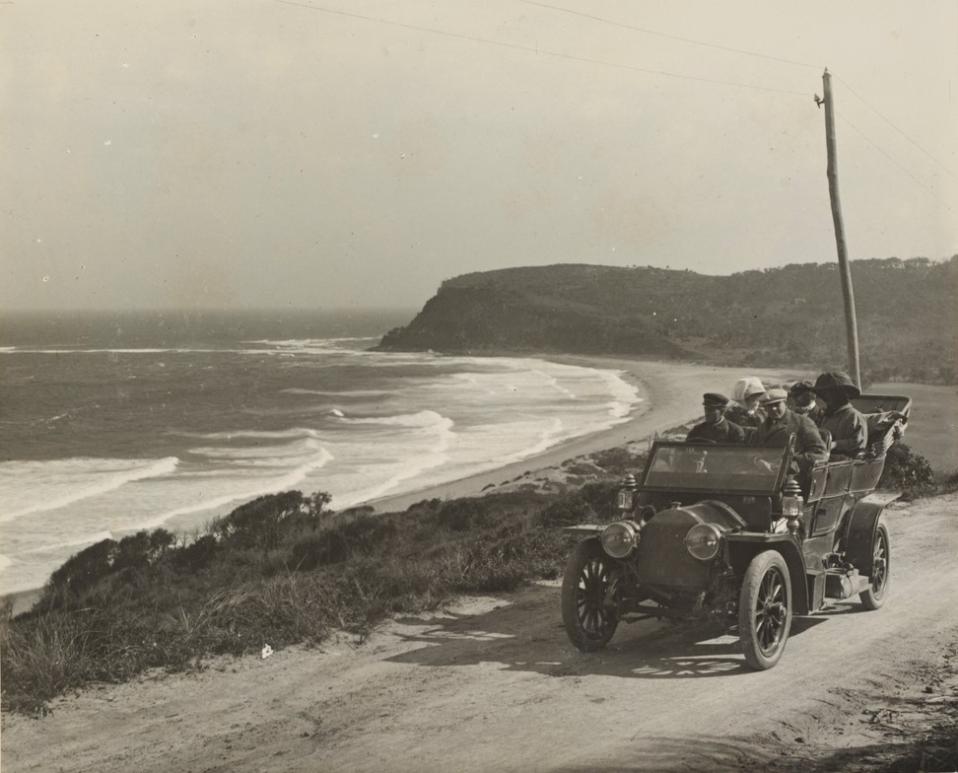Professor Christopher John Brennan: a poet of Newport beach
,_Australian_poet_and_scholar.jpg?timestamp=1552961417859)
Christopher John Brennan. Photo by May Moore.
Christopher John Brennan (1 November 1870 – 5 October 1932) was an Australian poet, scholar and literary critic.
Brennan was born in Haymarket, the eldest child of five who survived, to Christopher Brennan (d. 1919), a brewer who learned his trade at the Guinness brewery, Dublin, and his wife Mary Ann née Carroll (d. 1924), both Irish immigrants. After reaching Sydney about 1864, Mr. Brennan worked in R. and F. Tooth's Kent Brewery; he later became a publican.
Born November 1, 1870, in Harbour Street off Hay Street as one turns from the old Haymarket. My father was brewer at the Castlemaine Brewery in Hay Street and built his house where he could his work: he had at critical moments to visit it at night ... While the house was building we lived in Quay Street just behind and beneath the brewery. - Christopher Brennan, Curriculum Vitae
As a child he had typhoid (aged 6) and that, along with great academic ability, helped to make him the object of his mother's special affection and set him apart somewhat from his brothers, sisters and other children.
In 1880 he became the solitary acolyte at the Good Samaritan School and Convent, Pitt Street, and was intended for the priesthood. At 11 Brennan went to the Jesuit St Aloysius' College, where he first read Milton, whose poetry later had a deep influence on his own. Three years later, with a scholarship from Cardinal Patrick Moran, he went as a boarder to St Ignatius' College, Riverview.
Axel Clark states in an Australian Biography entry written about Brennan that;
Life at Riverview under the founding rector Fr Joseph Dalton changed Brennan greatly. He grew rapidly into a big, strong youth and experienced a major intellectual awakening: despite stringent physical and academic discipline, the school gave him great intellectual freedom, and whatever he wanted he was given to read. Most importantly, in Fr Patrick Keating, the classics master he found the only teacher ever to make a deep impression on him. Not an exceptional scholar by Jesuit standards, Keating influenced him not so much intellectually as morally. Brennan was captivated by his discipline, charm and elegance, and above all by his air of perfection, and was never to cease searching for that perfection, completeness and apparent infallibility which he had known in the faith of his youth, and in his favourite teacher. Just before leaving Riverview, Brennan abandoned his vocation, which distressed his parents, but not Moran or the Jesuits.
In March 1888 he went to the University of Sydney where to all appearances he led an adventurous, wayward life. None of his university teachers could stimulate him profoundly; for some, such as Professor Walter Scott, he felt little more than contempt. But for the first time he began to form strong and lasting friendships, with men of or near his own age, including J. B. Peden, A. B. Piddington, Dowell O'Reilly and J. Le Gay Brereton. As a student, Brennan distinguished himself for his scandalous neglect of set texts, and his ability to get good results without appearing to try. As editor of Hermes (1889-90) and as a prankster he seemed to his fellow students 'just a rollicking carefree chap'.
In private however, Brennan worked very hard at classical texts of his own choice, forming in 1888 an independent theory (now substantially accepted) about the descent of the extant manuscripts of Aeschylus. He also apparently suffered from moods of black melancholy and became passionately attached to the poetry of Tennyson and Swinburne. During the long vacation of 1889-90 he lost his faith and spent the rest of his life trying in philosophy, love and poetry to establish some new kind of absolute. He graduated B.A. in 1891 with first-class honours and the University Gold Medal in logic and mental philosophy, but only second-class honours in classics. In 1892 he won an M.A. in philosophy (conferred in 1897).
Systematic logical inquiry did not satisfy Brennan's fundamental religious needs. In 1891, most of which he spent rather adventurously as a teacher at St Patrick's College, Goulburn, he wrote his earliest surviving poems and, after an affair, embarked on 'virtuous' attachment. Returning to Sydney in October he taught part time at Riverview and had a second virtuous romance. In 1892 he won the James King of Irrawang Travelling Scholarship and studied at the University of Berlin in 1892-94.
Brennan entered the University of Sydney in 1888, taking up studies in the Classics, and won a travelling scholarship to Berlin.
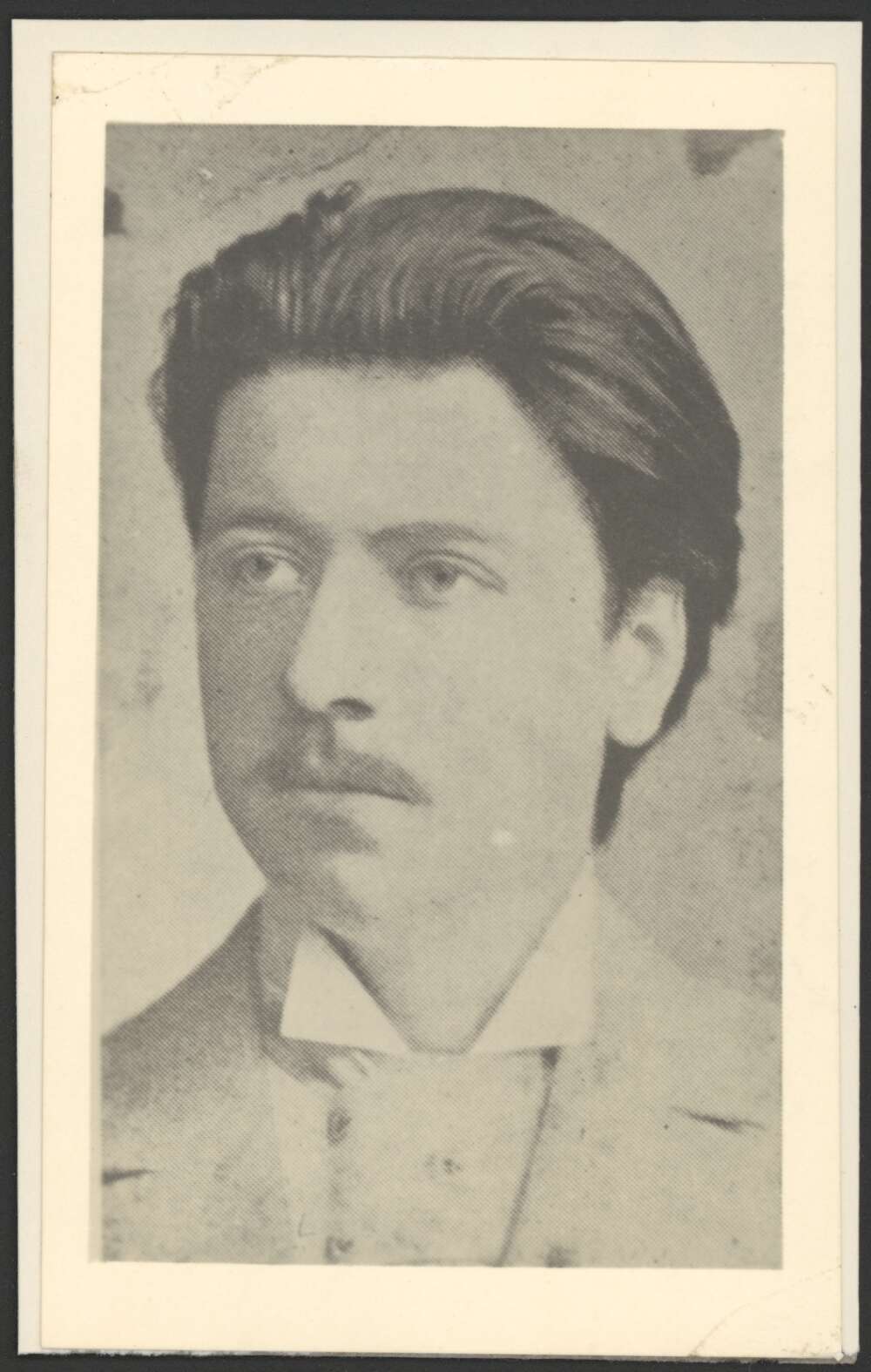
Portrait of Christopher John Brennan [1] Retrieved from http://nla.gov.au/nla.obj-137105181
There he met his future wife, Anna Elisabeth Werth; there, also, he encountered the poetry of Stéphane Mallarmé. About this time, he decided to become a poet. In 1893 Brennan's article "On the Manuscripts of Aeschylus" appeared in The Journal of Philology. Brennan began forming a theory about the descent of Aeschylus' extant manuscripts in 1888.
Returning to Australia in 1894, Brennan took up a position as a cataloguer in the public library, before being given a position as assistant lecturer in French and German in the department of modern languages and literature. He was employed from September 1895 in the Public Library of New South Wales to catalogue D. S. Mitchell's collection, becoming second assistant librarian on January 1st, 1907. According to Axel Clarke he was at that time better read in, and a more original critic of, European literature than anyone else in Australia.
Sydney University waited until October 1909 before offering him a permanent position as assistant lecturer in French and German in the department of modern languages and literature. He had been temporary lecturer in modern languages in 1896-97 and 1908-09, and in classics in 1908. Apparently a propensity for alcohol and the erotic interests shown in his first printed book of verse, XXI Poems (1897), were marked against him when he was being considered for various teaching posts.
Elizabeth came out to Australia in 1897 and they were married here - a poem by him and the Marriage Notice
Spring breezes over the blue, . .]
Spring breezes over the blue,
now lightly frolicking in some tropic bay,
go forth to meet her way,
for here the spell hath won and dream is true.
O happy wind, thou that in her warm hair
mayst rest and play!
could I but breathe all longing into thee,
so were thy viewless wing
as flame or thought, hastening her shining way.
And now I bid thee bring
tenderly hither over a subject sea
that golden one whose grace hath made me king,
and, soon to glad my gaze at shut of day,
loosen'd in happy air
her charmed hair.
1897
Marriages.
BRENNAN—WERTH.—December 18, 1897, at St. Mary's Cathedral, by the Rev. P. J. Walsh, Christopher, son of Christopher Brennan Esq., of Sydney, to Elizabeth, youngest surviving daughter of the late Rudolf Werth, of Ragnit, East Prussia. Family Notices (1898, January 26). The Sydney Morning Herald (NSW : 1842 - 1954), p. 1. Retrieved from http://nla.gov.au/nla.news-article14182653
They had four children:
BRENNAN ANNA H 33435/1898 CHRISTOPHER JANNA E PADDINGTON
BRENNAN ELIZABETH M 25166/1901 CHRISTOPHER JANNA E PADDINGTON
BRENNAN CHRISTOPHER R 15655/1906 CHRISTOPHER JANNA E MOSMAN
BRENNAN RUDOLPH W 15582/1907 CHRISTOPHER JANNIE E MOSMAN
Letters penned by him appearing in local papers show he was at Newport by at least 1917 and the National Library of Australia holds material showing letters to associates from 1911. Guy Jennings, in his 'The Story of Newport' (1987) records Mr. Brennan bought land in Newport in 1903, initially for a weekend retreat.
Their daughters were early members of Newport SLSC, as were their sons - Chris Jnr. more so than Rudolph. Newport SLSC’s records in its excellent History compiled by Guy Jennings (Newport Surf Life Saving Club: The First Century 1909-2009) has a postcard, the back of which reads “This picture is historic and represents the first girls life saving team formed in the world. They succeeded in reaching the buoy at their first public surf carnival at Dee Why in 1910. The men’s team failed (the) water was rough and heavy with kelp which tangled lines”
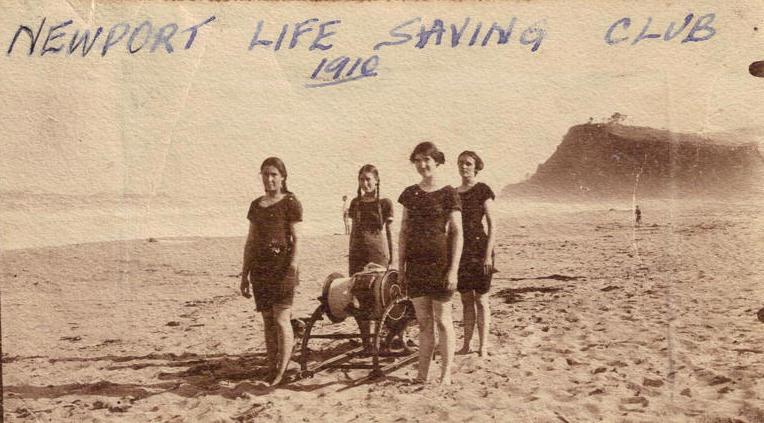
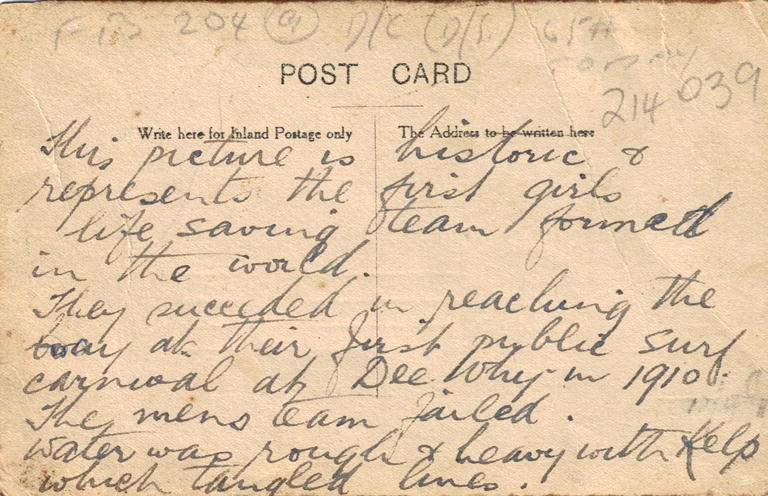
The three Hope sisters and Vera Lewis - one of the first in the world girls life-saving team, 1910; Women in at the beginning of Newport Surf Club - Annie Brennan, Elsie Brennan, Muriel Bulfin (Newport School and Hotel), Alto Corner, Olive Corner, Doris Hope, Francis Hope and Winn Hope - to name a few!
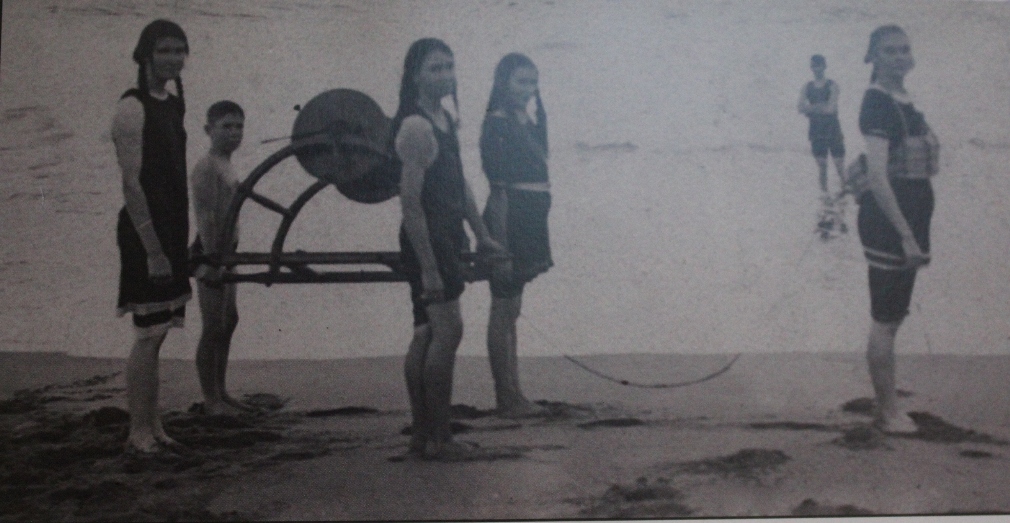
Constable ,T. Hewitt, of Newport, has for some time past, been busy in instructing the members of the Newport Surf Bathing and Life Saving Club in the methods of the Royal Life Saving Society, and hopes in a few days to present his candidates for examination. AMONG THE BREAKERS. (1910, January 20). The Star (Sydney, NSW : 1909 - 1910), p. 2 (LATEST EDITION). Retrieved from http://nla.gov.au/nla.news-article228320867
Newport Surf Club reports the formation of a life- saving class among its members. AMONGST THE BREAKERS. (1910, March 17). The Star(Sydney, NSW : 1909 - 1910), p. 2. Retrieved from http://nla.gov.au/nla.news-article228308015
Guy records about Prof. Brennan;
'He had always had an abiding love for the sea and his wife would often be seen driving her horse and trap and fishing around Newport. He called his house 'Oceania', the name for present day Oceania Place.:
XXI Poems: Towards the Source, 1897 (Item 13) - NLA
Brennan's working copy for the preparation of the text of POEMS, 1913. The title page, and 4pp of text have been removed.
Half-title has been altered by the poet to read Poems by C.J. Brennan Below this he has written, "The new volume (to be published by G.B. Philip & Son) is to begin like this booklet, i.e., the half-title must be the first page of a section, the title-page the third, etc., etc." The printer or publisher's editor however, ignored this instruction.
The text of some of the poems has been amended; lower case letters at the commencement of certain lines have been replaced by capitals; poems which are to be omitted are cancelled through and annotated; and dates have been added to those poems intended for inclusion in the new volume.
An interesting feature of this volume is the punctuation. Brennan has worked carefully through all the poems adding marks copiously. He has deleted many of the existing marks and substituted others. But when Poems was printed, the punctuation was again revised in certain passages. The only certain thing about Brennan's punctuation was its uncertainty, for it was always a nuisance to him.
The book is bound in half-blue morocco. A Riviere binding, with specimens of each of the four variant "Brennan" bookplates etched for me by Sir Lionel Lindsay. These have been laid down on the end papers.
Inserted is an autograph letter from Brennan to Brereton. n.d., 3pp, 8vo. Written from Newport during 1911. After comment upon the Nibelungen theories of Lachmann, and some rather puzzlingly constructed German phrases, Brennan continues: "I have not yet got Lilley's Magazine - its a bore having to go to the P.O. here...This scrawl keeps varying: a bad pen...Its possible - keep even the possibility a dead secret from every and any person whatsoever - that I may drag out the somewhat ancient corpse of my poetic past ('Master, he stinketh') and try and embalm and coffin it properly: in which eventual case I should require your counsel... But let even this far off whiff from the sepulchre remain between us two. Yours, C.B."
This was probably Brennan's first intimation to his friend of his intention to publish a collected edition of his poems.
"The Wanderer" (Item 46-48)
Reproduction in colour of crayon drawing by J. Phillips of "Oceania", Brennan's old home at Newport.
The vicinity and junction of Myola Road, Oceania Crescent and Walworth Avenue Newport looks to be the location of Prof. Brennan's original stone and fibro Newport home.

.jpg?timestamp=1553020400251)
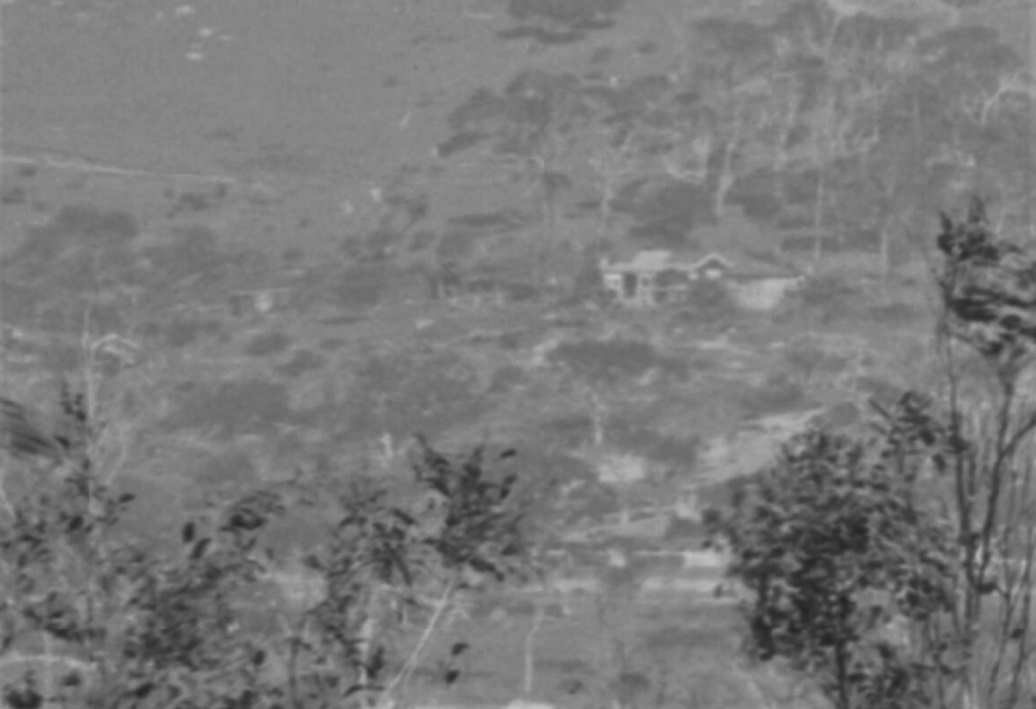
Panorama of Newport, New South Wales [picture] / EB Studios; between 1917 and 1930, Image No.: 6154744, courtesy National Library of Australia. And enlarged sections from http://nla.gov.au/nla.obj-162419378
An article from 1948 regarding a bush fire (below) describes 'Oceania' as a six roomed stone and fibro structure. An article during divorce proceedings that weren't followed through on indicates the Brennans had two cottages and four acres at Newport and that it was his wife who actually owned the properties as well as a motor launch, motor cycle with side car, cattle, a trap(buggy pulled by horse) and land and a house at Mosman.
The name for the home became the name for Oceania Crescent, Newport Beach.
In November 1900 his wife's mother Anna Werth came to Sydney bringing with her, according to Axel Clark, 'a deranged daughter' and his prior to then happy marriage began to crumble.
Clark states [1.] that prior to then:
She (Elizabeth) had studied music: those who knew her in the 1890s remembered her playing the piano and singing songs of 'haunting sweetness'; they also remembered her beauty — her glorious golden hair and blue eyes.
The pressures of rearing four young children, disparate points of view, the presence of a mother who did not like or approve of him and his recourse to drink caused problems. This poem, seemingly describing him bypassing the family home at Mosman and going to Newport perhaps gives insight into his own perspective. It was among the 1914 published book of his major work, Poems: 1913.
When window-lamps had dwindled, then I rose . .
When window-lamps had dwindled, then I rose
and left the town behind me; and on my way
passing a certain door I stopt, remembering
how once I stood on its threshold, and my life
was offer'd to me, a road how different
from that of the years since gone! and I had but
to rejoin an olden path, once dear, since left.
All night I have walk'd and my heart was deep awake,
remembering ways I dream'd and that I chose,
remembering lucidly, and was not sad,
being brimm'd with all the liquid and clear dark
of the night that was not stirr'd with any tide;
for leaves were silent and the road gleam'd pale,
following the ridge, and I was alone with night.
But now I am come among the rougher hills
and grow aware of the sea that somewhere near
is restless; and the flood of night is thinn'd
and stars are whitening. O, what horrible dawn
will bare me the way and crude lumps of the hills
and the homeless concave of the day, and bare
the ever-restless, ever-complaining sea?
by Christopher Brennan
From book: Poems (1913)
Originally in III: THE WANDERER (Sequence)
1902–
Elizabeth's mother Anna Marie passed away in 1919, aged 78, at Royal North Shore Hospital - the death registered at St. Leonard's. The daughter who came with her, Helene, passed away in 1932, the same year he died - Helene's death was registered at Balmain South.
Some published items from the pen of Prof. Brennan while at Newport:
TO THE EDITOR OF THE HERALD.
Sir,-Last night's meeting shows that Mannixism is now well established in Sydney, with its delegates and its expounders-chiefest and most eloquent the Rector of St. John's College within the University-and its organisation, apparently furnished by the Catholic Club. It may be expected then that from such an authoritative body definite answers will be returned to definite questions. For hitherto, in their zeal to "repudiate and re-sent," the apostles of the doctrine among us have forgotten their primary duty of presenting and explaining.
What Is the doctrine? What is its meaning, its intention, and purpose? Wherein and how are we to put "Australia first?" To what might we prefer it? To it what postpone? What need exists for preaching the doctrine? What special urgent need for preaching it just now? And how is it to be practised in the present crisis of our and the world's history?
As for the general need for its inculcation, the learned Rector of St. John's College seems sufficiently to have disproved that he has shown us how, from the beginning of our constitutional history, we have successfully com-bated every attempt on the part of the Imperial Government to interfere in our affairs. He finds this fact "important." It is.
Nevertheless, the founder of the doctrine, "seeing conditions here, though that a little of 'ourselves' would be good for Australia." That is to say, he set about the establishment of an Australian Sinn Fein. Now Sinn Fein, the learned and eloquent Rector tells us (with a simplicity so "pathetic," that "tears" mingle with one's laughter), "is not a secret organisation."' Let us give it what- ever credit is its due; it is not. In the proclamation of the Irish Republic it openly avowed the alliance of holy Ireland with the Prussian, the Bulgar, and the Turk. And the would-be founder of Sinn Feinism in our midst is notorious for his description of the present conflict with blatant evil as "a sordid trade war." Those among us who have kinsmen in the fight may have been moved to resentment at this thrice-stupid utterance. But why be disturbed? Why not rather laugh at the borrowed plumes? Apart from the adjective, he has not even the sorry merit of having originated the phrase. It had been uttered long before, within four days of the declaration of war, by a high dignitary of another church-Mr. W. J. Miles, of the Rationalist Association. Mr. Miles, of course, is only too delighted to find so distinguished a brother in the faith. Quite recently, he lent his countenance to the public declaration that "If it was wrong to follow Archbishop Man-nix, it was equally wrong to follow Cardinal Mercier." Verily a novel eirenicon.
It would be well then if the gentlemen who congratulated the founder of what, until its faithful supporters give it an official name, will be most conveniently known as Mannix-ism, on "his splendid stand on behalf of Australia's democratic rights," were to tell us plainly and exactly what they mean. What are Australia's democratic rights to him or he to them? How, by following him, shall we set Australia first? and to whom shall we say: "Get thee behind me?" The answer is, perhaps even more advisable and more urgent. In these gentlemen's own interests, than it is necessary for the enlightenment of the public. For by their advocacy, here and now, of Sinn Feinan organisation, let us remember, which has already once made war-and by their championship of its would-be founder among us, they have brought themselves under grievous suspicion of be-longing to those who would glut an irrational hatred of England at the expanse of civilisation generally, and, first and chiefly, of the land which some of them have been good enough to adopt. At what cost to them-selves, if this be so, let themselves see; but that Australia shall not thus be put "first" is the business of everyone who, to the "un-warrantable asumption" of Australian birth, joins the arrogance of desiring to see his own country first in the way of honour, faith, and integrity.
I am, etc.,
C. J. BRENNAN.
Newport, Nov. 28.
TO THE EDITOR OF THE HERALD. (1917, November 30). The Sydney Morning Herald (NSW : 1842 - 1954), p. 9. Retrieved from http://nla.gov.au/nla.news-article15741811
DR. MANNIX.
TO THE EDITOR OF THE HERALD.
Sir,-It may well be that the only article of Mannixism adopted here is the recommendation to vote "No" on the 20th, in which case the reasons set forth with such fulness and vehemence by the reverend rector of St. John's College would constitute a fairly satisfactory statement of the doctrine as adapted to local requirements. But not even in that case would they constitute an answer to my ques-tions. I said nothing, and say nothing, about the referendum. I asked, concerning Mannixism, "What is the doctrine? What is its meaning, its intention, and purpose?" And to show why I put the question, and what it was that I desired to know, I set forth the two points of the doctrine which are the gravamen against it. These are, I repeat, the glorification of Sinn Fein, with its German alliance, and its betrayal of civilisation, and that "sordid" phrase which I shall not here again set down. Has the latter been with-drawn? Not to my knowledge. Its author (at second hand) is now telling us that he "has said and will say over and over again" that England was "quite justified" in going to the assistance of Belgium, etc. Brave words! But who ever wanted to stop him from saying so? And who gives him any thanks for saying so now? For he joins to them such a largeness of reservation-and the tangled nature of human affairs, always and everywhere, allows full scope for malignant interpretation-that the back door is still kept wide open for the admission of the old slander. Whether this be "trimming," or hedging, or what not, let him settle by means of his own private lexicon; the bulk of men have too honest a sense and are schooled too much, by their ordinary occupations, to simplicity of judgment to have much respect for these subtleties. It is enough for them to know who is for us; for he that is not is against us.
He is set before us as a prophet of the doctrine of "Ourselves," as a defender of Australia's democratic rights. I asked, and I ask again: "What are those rights to him or he to them?" For I note that, when criticised, he thought it a sufficient answer to say that the critic was only an Australian; that he has declared that he will not regard a majority vote as binding unless it agree with his opinion: and that he has expressed his approval of the hooliganism of Warwick, calling it "a touch of Sinn Fein"-evidently, in his opinion, the superlative of praise, but really the basest thing yet said about that unfortunate organisation; a saying quite on a level, for dulness and vulgarity, with the first insult that he hurled at our intellect and con-science. And we shall not decline such champions as this? They shall come amongst us to tell us what our history has been, and we shall not question their knowledge? To tell us how to make it, now, and in the future, and we shall not question their sympathy, their zeal, their sincerity, and their dis-interestedness? I have questioned them, I suspect them, and my suspicions are not re-moved, my questions are not answered by an eloquent exhortation to vote "No" on the 20th.
The reverend rector's letter, then, as it is no answer to my questions, requires no answer from me; nor would I, indeed, enter on any peevishly meticulous criticism; slight excesses here and there are but the necessary exuberance of that well-known perfervid quality. One issue, however, that he has raised, tempts me into tho impertinence of a personal declaration, and if one once begins that kind of thing one might as well go through with it to the end for the sake of frankness and completeness. I therefore ask a certain indulgence for the length of following remarks.
I have written on this subject purely as an Australian, who desires no other abiding city than this city of his birth, here on the shores of Port Jackson. But, among other things, I was an obscure and undistinguished pro-Boer, as the term was, a convinced and un-repentant one, say, of the type of Louis Botha or Jan Smuts. Now, when a man comes along and tells me that those times are back on us again I can only stare at him in amaze; if he persists, I can only begin to be uncertain whether the grounds of his former convic-tions are the same as those which, in my own case, I hold to be reasonable and just. When it comes to "Maffickism" I cannot see anything more than a turnip-headed bogey and a jingling name invented ad hoc to draw off attention from a real evil.
Further, while writing as an Australian, I cannot forget, and have no wish to forget, that I am Irish In blood and bone. My be-lief in Home Rule has survived even the great betrayal of 1891. The Sinn Fein I have judged entirely from their own statements and those of their apologists, and I have condemned them only for their alliance with Germany. This is their crime, their sin; this is the shame they would have put on us; and I resent it as fiercely as I loathingly sicken at the immoral sentimentalism which would not merely palliate their treachery, but palm them off on us as poets, dreamers, lovers of Ireland, martyrs, heroes, and what not. And even if they had not joined hands with Germany, they would still have tried to stab civilisation in the back; they would still have deserved stern condemnation, for this is not the time to cry "Ourselves;" the only watchword now is "All of us together." Whosoever has eyes to see, let him open them; and he will behold that vision of evil, having power for a time, and times, and half a time-and the end is not yet!-which is the reality of these latter days. If any man has so besotted his mind with the super-stition that England can never do anything that is good, that he cannot see this thing, gross as the world, let him, for pity's sake, keep his wretched infirmity unpublished. This is the day of the judgment of nations and men, and all shall be judged by the way they have stood towards that evil. To do its work, to help it, to refrain from combating it, to hinder those who would combat it-it knows where to find its ministers for these tasks; and of such ministers we know the names of two-in Ireland, Sinn Fein; in Australia, Mannixism.
I am. etc.,
C. J. BRENNAN.
Newport, Dec 4.
DR. MANNIX. (1917, December 7). The Sydney Morning Herald (NSW : 1842 - 1954), p. 8. Retrieved from http://nla.gov.au/nla.news-article15760517
What is most of interest to Newport residents, Pittwater people and in fact the whole of the northern beaches, is that he did pen some of the poems for which he became so well-known. This one written at Newport at the close of WWI perhaps reflects that horror, especially for the people of Newport then, who lost so many sons to this conflict - the Porter sons as one instance, with five young men leaving here and only two returning home and both those irreparably damaged - Visit: The Porter Family- Newport: Five Soldier Brothers Who Served During World War I
It is also worth noting this item held by the National Library of Australia:
Chisholm, Professor A.R (Item 84)
Christopher Brennan Extract from the Bulletin, Sydney, July 16, 1958
In quarter-leather folder, together with original print of the portrait of Brennan by Geo. W. Lambert, which was reproduced as illustration to the article. The print is annotated by James Tyrrell, as having been drawn in 1894.
In this article Professor Chisholm mentions the Casuals' Club and that the harmony of the meetings was disturbed by the disagreement between Brennan and Brereton over the 1914 War; Brennan accusing his friend of pacifism.
Inserted: Autograph letter from Brennan to Brereton, 1p, Newport, n.d. Brennan commences: "Dear Brereton, as I thought - like all men of peace you're somewhat indiscriminate in your massacres". The letter concludes, "Yours ever, C.B."
The folder contains letters from Professor Chisholm to H.F.C., mostly about The Burden of Tyre and the Collected Brennan, also reviews and extracts from various journals, all of Brennan interest.
DOOM.
Dead night, unholy quiet, doom, and weird
Are heavy on its roof,
The palace-keep that prosperous Evil rear'd
Defiant, heaven-proof.
Founded in fraud, mortar'd with blood, and
clamp'd
With clutching iron hands,
It frown'd down right, its flaunted scutcheon
ramp'd
Above the abject lands.
And now, the sentinels have left that gate
Nor bar protects, nor pin,
But high and wide the portal yawns, till Fate,
And Judgment enter in.
A groaning trembles thro' the massive vaults,
A muttering down the halls,
As closer yet the impending thunder halts
Nor yet the levin falls.
A panic whispering round the gallories
Runs twittering: then the hush,
And in the dimmest nooks divining eyes
See blackness throng and crush.
Palsied, with fix'd and writhen face, high Sin
Stares from the shrouded throne
With glassy eyes whose gaze is turn'd within
-Where at the last are known
Ate and Ruin, each Erinys-shape
Dire, ineluctable,
From whom nor death nor madness brings
escape
-And least, the House of Hell.
This is their doom, deserv'd, complete and
due,
That they themselves must know
Whose witless hand it was that overthrew
With self-inflicted blow
Their monstrous dream; to know their own
the sword
That smote them from the skies,
That stretch'd in dust the Dagon they adored,
And shatter'd their emprise;
Their own the skill that most industrious built
This pit of their despair
Star-high, smooth-rounded, baffling, where
their guilt
Must find eternal lair.
The enginery they wrought, whose maw they
fed
With fume and fire of hate,
To break his house above their neighbour's
head,
Hath left theirs desolate.
And Evil knows at last, all overtoil'd,
The law whereby it must,
By self stupidity and dulness foil'd,
Still labour for the Just.
This is their punishment: there is no worse;
What have they left to dread?
What reek they of the living orphan's curse,
The slow wrath of the dead?
Tho' for a while, lest from the festering lie
Our air drink poison-shade,
The scavengers of Justice yet must ply
Their stern and simple trade,
* * *
(For sword and rope are hungry,axe and
block
Demand their grim repast,
Whereof who would defraud them, shakes
the rock
On which his house stands fast)
Our vengeance now is full: what else must fall
Can add no best, no worst;
The cup is brimm'd whence they have drunken
gall,
Where we have slaked our thirst.
Our vengeance is complete, deserv'd, and won,
And sevenfold seventyfold
The retribution on the guilty one
Is levied, summ'd, and told.
We that have suffer'd with the suffering
right-
For all our doubts and fears,
For all our anguish in the muttering night,
For all our blood and tears,
For dread and for dismay, and that foul rape
Man's spirit but scarce withstood
When from the Pit, in our usurped shape,
The Abominable was spewed-
Lo, their cold agony and icy sweat,
Their self-damnation known!
Let Justice come: What need we vengeance
yet?
Its wreaking was their own.
Newport, Nov. 3-4. C. J. BRENNAN.
DOOM. (1918, November 9). The Sydney Morning Herald (NSW : 1842 - 1954), p. 12. Retrieved from http://nla.gov.au/nla.news-article28099821
This letter to one of his publishers and the reply sheds more light on why he may have been perpetually struggling financially and also his attitude towards WWI. Although not shown widely told in the records (unless you read one of the many great volumes written about him) Mr. Brennan was generous with his money, gave loans to friends, and did not press for repayment, even when in dire straits himself. The letter penned by him also shows us his usual times for being at Newport:
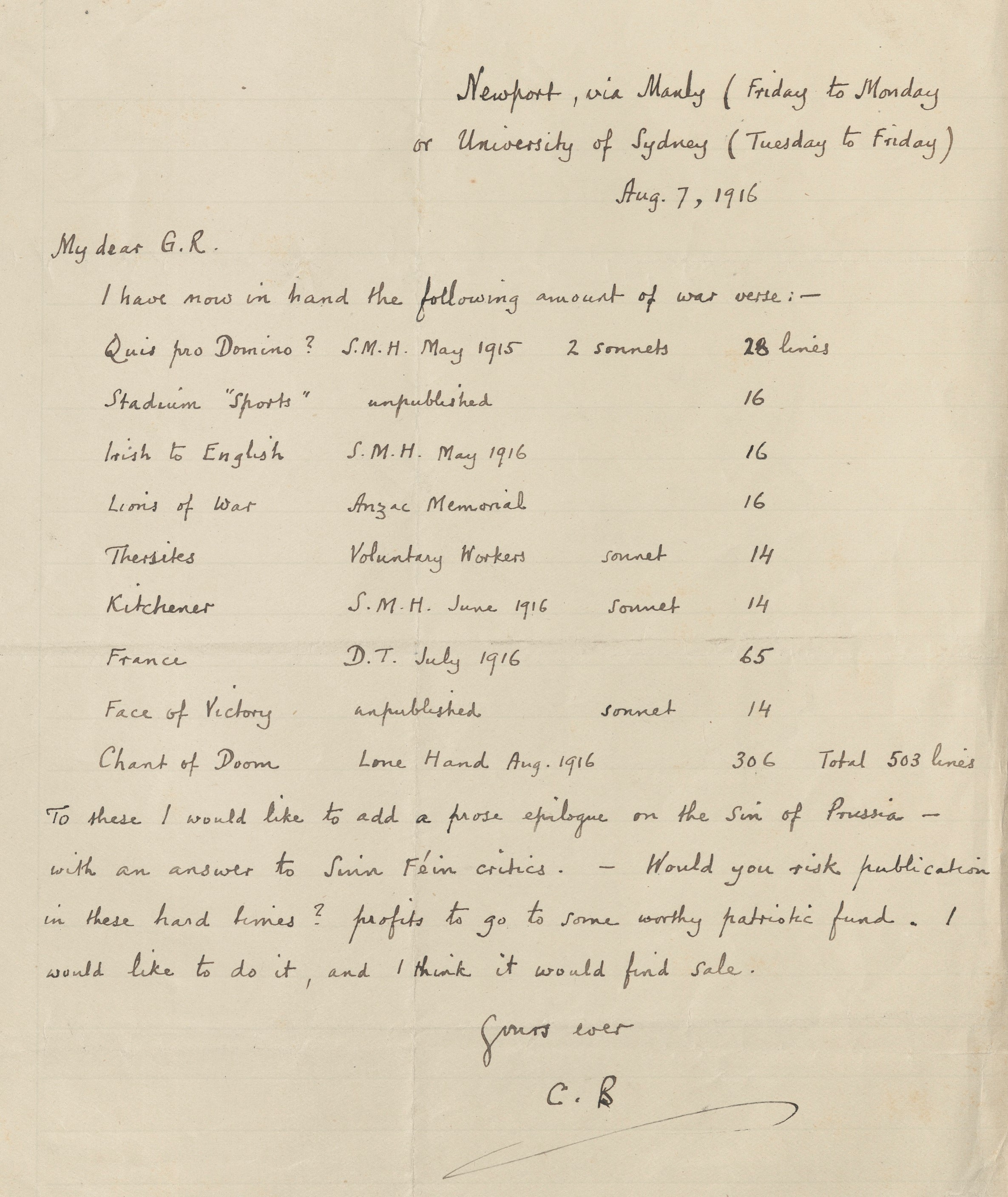
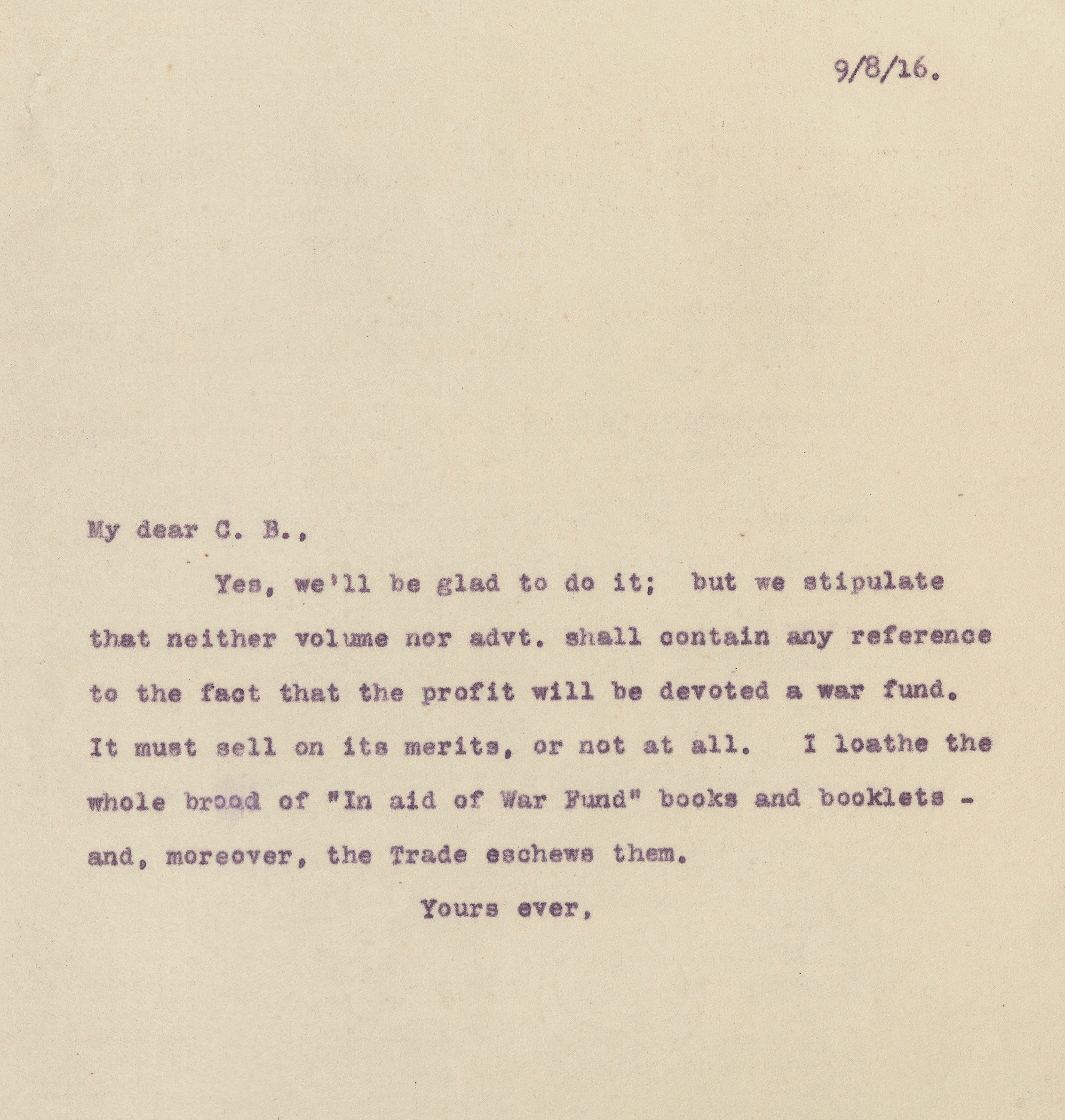
Angus & Robertson correspondence files from Christopher John Brennan to W.E. Brenton (and G.R.), 1900-1932, Items No.: c11980_0014_m and c11980_0015_m courtesy Mitchell Library, State Library of New South Wales
It is also among these letters where his struggles with neuralgia (intense, typically intermittent pain along the course of a nerve, especially in the head or face) are spoken of by him and how treatments prescribed, 'powders', usually left him dazed.
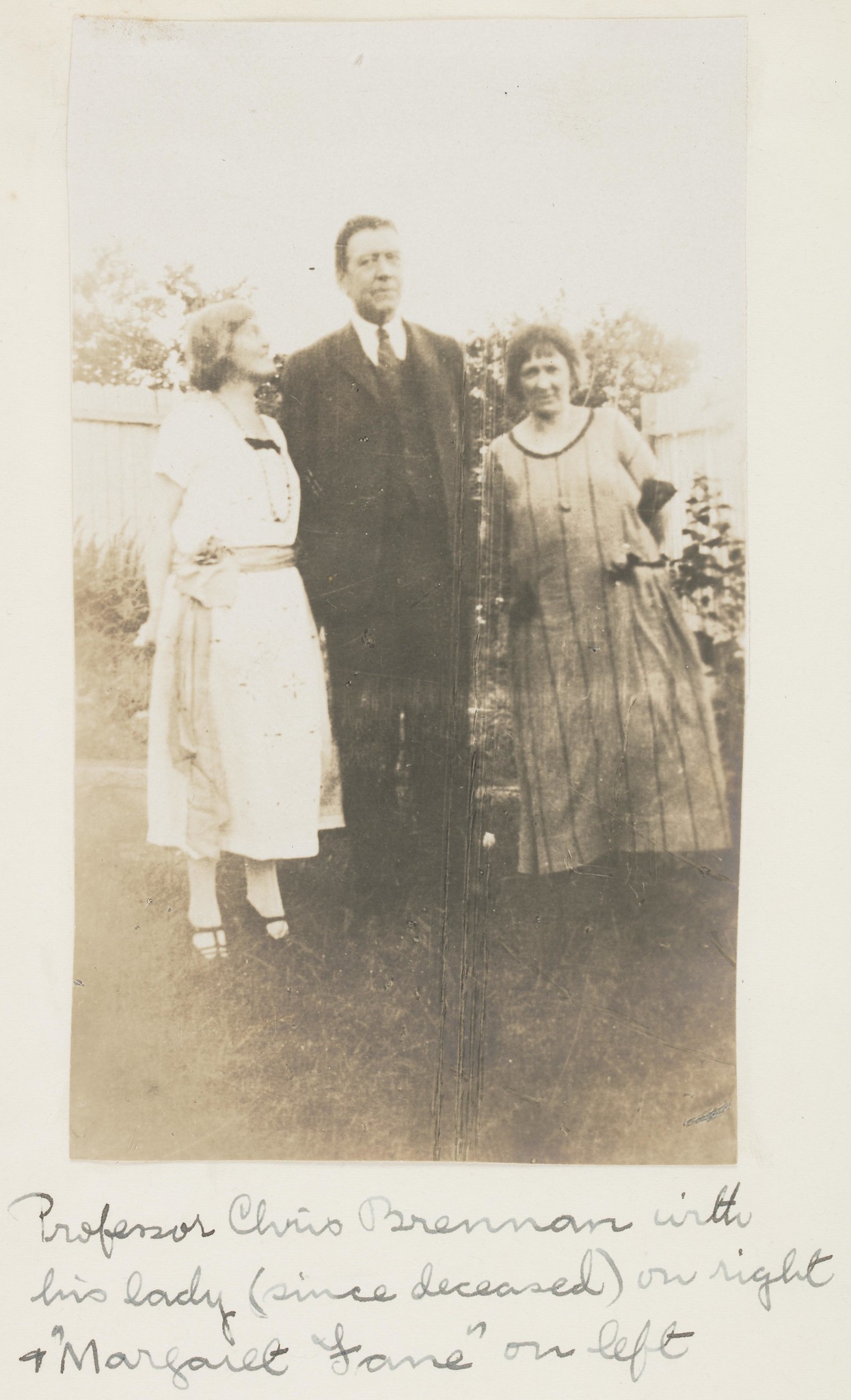
Christopher Brennan, Mary Ann Brennan (?), Margaret Fame, Angus and Robertson pictorial material - Portraits of authors and sketches, Digital ID: c14084_0017_c, circa 1920, courtesy State Library of NSW
In 1920 he held the position of associate professor in German and comparative literature at the University of Sydney. In 1922, he went to live with Violet Singer, the 'Vie' of his later poems, and, as a result of increasing drunkenness, was removed from his position at the University in June 1925. Although some biographers state he was divorced from his wife, newspaper reports show that although they were going through those proceedings his wife applied to have them ended prior to them divorcing.
The couple also lost their youngest daughter in 1922, who died in childbirth, which may shed further insight into what else was happening or affecting them in that year. His youngest daughter married in 1920:
BOWEN— BRENNAN
At St. Andrew's Cathedral on February 25th, the Rev. Canon Charlton celebrated the marriage of Mr. Charles James Bowen (late A.I.F.), son of Mr. and Mrs. Samuel Bowen, of "Winifred", Albert-road, Strathfield, and Miss Elsie Brennan (Elizabeth Mary) second daughter of Mr. and Mrs. C. J. Brennan, of Newport. The wedding, which was a quiet one, was attended by the parents on both sides, and the sisters of the bride and bridegroom. After a luncheon at Paris House the young couple left for a honeymoon at Jenolan Caves.
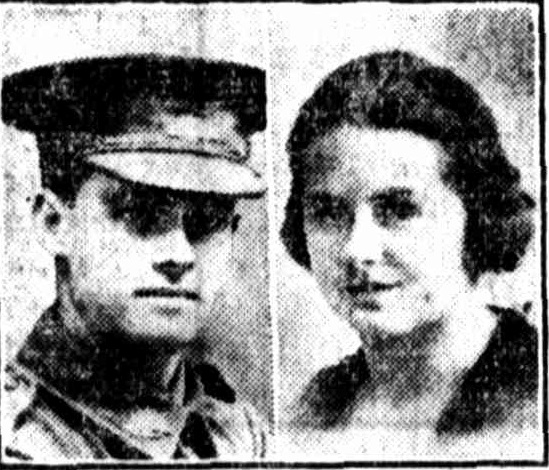
BOWEN -- BRENNAN (1920, April 18). The Sun (Sydney, NSW : 1910 - 1954), p. 14. Retrieved from http://nla.gov.au/nla.news-article222414537
BOWEN.-- November 18, 1922, at Manly, Elizabeth Mary (Elsie), dearly loved wife of Charles J. Bowen, of Newport, aged 21 years. Family Notices (1922, November 20). The Sydney Morning Herald (NSW : 1842 - 1954), p. 8. Retrieved from http://nla.gov.au/nla.news-article16040646
FUNERALS.
BOWEN.—The Relatives and Friends of Mr. CHARLES J. BOWEN, of Newport, are kindly invited to attend the Funeral of his dearly loved WIFE, Elsie ; to leave our private Mortuary, 92 Corso, Manly, THIS (Monday) AFTERNOON, at 2.30 o'clock, for the Manly Cemetery. T. WAUGH and Co. Tel., Manly 42.
BOWEN.—The Relatives and Friends of Professor and Mrs. CHRISTOPHER BRENNAN, of Newport, are kindly invited to attend the Funeral of their dearly loved youngest DAUGHTER, Elsie; to leave our private Mortuary, 92 Corso, Manly, THIS (Monday) AFTERNOON, at 2.30 o'clock, for the Manly Cemetery. T. WAUGH and Co. Tel., Manly 42.
BOWEN.—The Relatives and Friends of Mr. and Mrs. SAMUEL BOWEN, of Winifred, Albert-road, Strathfield, are kindly invited to attend the funeral of their dearly loved DAUGHTER-IN-LAW, Elsie Bowen ; to leave our private Mortuary, 92 Corso, Manly, THIS (Monday) AFTERNOON, at 2.30 o'clock, for the Manly Cemetery. T. WAUGH and Co. Tel., Manly 42. Family Notices (1922, November 20). The Sydney Morning Herald (NSW : 1842 - 1954), p. 7. Retrieved from http://nla.gov.au/nla.news-article16040848
Samuel Bowen's house in Beaconsfield street which he named 'Winifred' after his daughter. Photo courtesy Charles Nettleton - sourced from Guy Jenning's 'The Newport Story' (1987).
Samuel Bowen, Charles' father, had been at Newport for a while too. He and his wife, Caroline (nee Moreton), married in 1887 and Charles was born in 1895:
MARRIAGES.
BOWEN— FROST.— October 24, by the Rev. F. B. Boyce, at St. Paul's Church, Redfern, Samuel Bowen, of Redfern, to Caroline Moreton Frost, of Ultimo. Family Notices (1887, November 19). The Sydney Mail and New South Wales Advertiser (NSW : 1871 - 1912), p. 1103. Retrieved from http://nla.gov.au/nla.news-article165225509
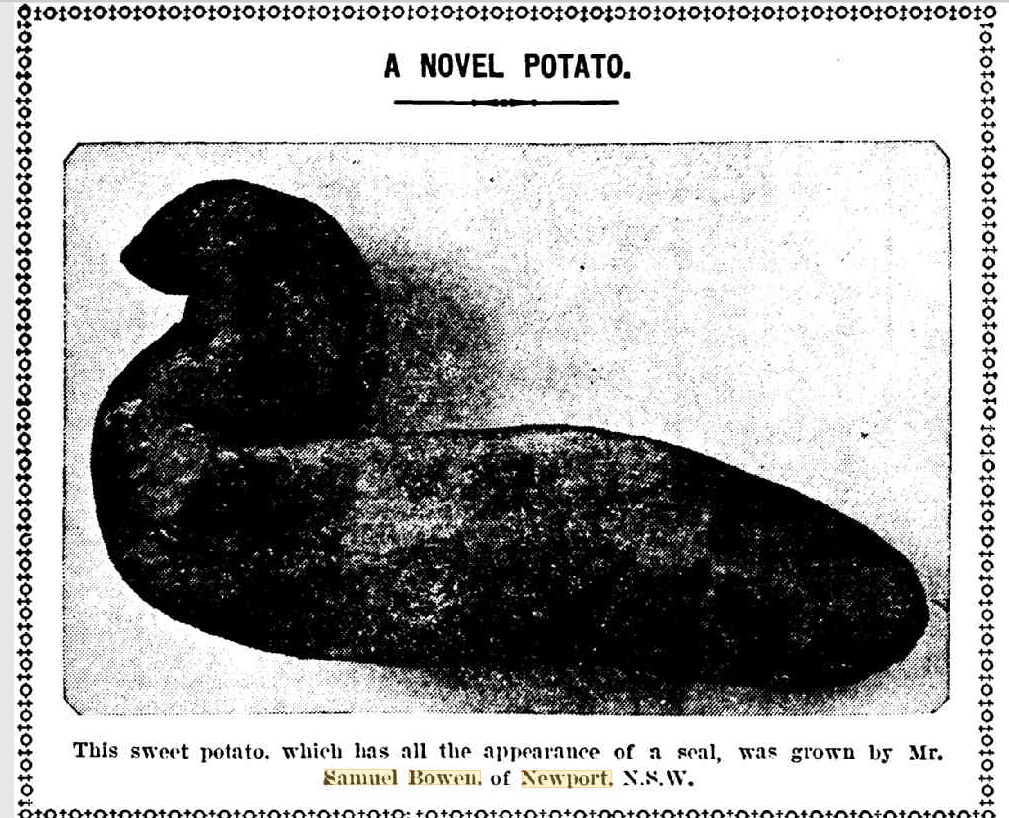
A NOVEL POTATO. (1907, May 11). The World's News (Sydney, NSW : 1901 - 1955), p. 9. Retrieved from http://nla.gov.au/nla.news-article128280019
Samuel Bowen also had problems later on of a family kind, unfortunately when he was 85!, as told by some of the sensationalist newspapers of the time, his daughter 'Winifred' didn't have the run of the roost at the home named for her, even when she came to live there to look after her ageing dad:
NO EVICTION ORDER
AN application by a woman to have her husbands adult son and married daughter evicted from their Newport home was refused by Mr. Justice Clancy at the Supreme Court on Thursday. The woman, Mrs. Dulcie Bowen, said that in November Mrs. Winifred Stella Crystal, daughter by a previous marriage of 84-years-old master tailor, Samuel Bowen, together with a woman friend and a man she thought to be Mrs. Crystal's son, had forced an entry into the home. They had forced her and her ailing 13-years-old son to live in one room, said Mrs. Bowen. Bowen, in an affidavit, said his children were in the home by his invitation because his wife would not cook for or look after him. NO EVICTION ORDER (1949, January 9). Truth (Sydney, NSW : 1894 - 1954), p. 13. Retrieved from http://nla.gov.au/nla.news-article168881052
HOME INVADED, SAYS WIFE !
A woman said in the Supreme Court today that although she rented a Newport home from her husband, her step-children would allow her in only one room, and she had to eat all her meals out. She is Mrs. Dulcie Bowen, of Winifred, Beaconsfield Street, Newport, third wife of 85-year-old tailor, Samuel Bowen. Mrs. Bowen took proceedings against Bowen's children of his first marriage, James Charles Bowen, and Winifred Stella Crystal, of the same address, claiming they were in unlawful occupation of portion of the house.
Mrs. Crystal and Bowen jun. claim they have leave and licence from Bowen to occupancy. Subject of what was described by Mr. Justice Owen as "a family brawl," was an iron roofed, weather board-cottage, which Mrs. Bowen said had the windows broken, verandah falling in, holes in the front door and floors, and riddled with white ants and-borers. Mrs. Bowen said that she had a weekly tenancy from her husband and paid, him £1 a week. After a disagreement with Bowen, said Mrs. Bowen, Mrs. Crystal and Bowen jun. had forced their way into the house in November last and had since refused to move. Mrs. Bowen said defendants had pushed her into one room and wouldn't allow her to use the bathroom, dining room, kitchen, or back door. "My small son and I have to eat all our meals out," she added. Samuel Bowen said he could not remember seeing a solicitor about giving his wife the tenancy of the house, and to his belief had never given anyone the tenancy. HOME INVADED, SAYS WIFE (1949, April 11). The Sun (Sydney, NSW : 1910 - 1954), p. 3 (LATE FINAL EXTRA). Retrieved from http://nla.gov.au/nla.news-article231077305
NOT MUCH ROOM ON THE HOME ROOST, SAYS WOMAN
SOMETHING quite remarkable is the set-up in the cottage of aged Samuel Bowen in Beaconsfield St., Newport. There, ensconced under the one roof are the 85-years-old Bowen, wealthy property owner, his third wife, and his son and daughter of his first marriage.
All is not well at the roost, however, as was made more than plain at the Supreme Court on Monday. The third Mrs. Bowen complained to Mr. Justice Owen and a jury of four that she had been pushed into one room, was refused the use of the rest of the place, and was forced to eat out.
Mrs. Bowen claimed that although she was the tenant of her husband, and as such lawfully occupied the premises, Bowen's son and daughter, James Charles Bowen and Mrs. Winifred Stella Crystal, were in occupation. Son and daughter, on the other hand, claimed that they had been given leave and licence by their father to occupy one bed-room, the verandah, and to have the use of the kitchen, bathroom, dining-room and passages.
.jpg?timestamp=1553026931143)
Mrs. Crystal
In reply to this, Mrs. Bowen claimed that their father had no right to give them such permission, and sought a finding that would give her the full rights of a tenant.
In his day, Sam Bowen was one of Sydney's best known businessmen. He ran what was probably the biggest tailoring business of its kind at Railway Square for years, and Bowen's Building stands there as a monument to his business ability. At one time, too, he took quite an interest in politics, and for years was campaign director for the late R. D. Meagher.
Bowen wed the present Mrs. Bowen in March, 1946. The trouble which brought Mrs. Bowen to court did not develop until November last year. Mrs. Bowen took the stage first. She told the court that a lease was drawn up at the office of Messrs. R. D. Meagher, Sproule and Co., by which she was to have the use of the place for 10 years at a yearly rental of £65. This lease, she said, never came into effect, because she pointed out to her husband that the place was riddled with borers and white ants, windows were broken, and there were holes in a door.
Bad Memory
Later, she was given a tenancy at £1 per week, she said. On November 26, said Mrs. Bowen, Mrs. Crystal came to live at the house, followed by young Bowen three days later.
To Mr. D. S. Hicks (for the son and daughter), Mrs. Bowen said: "They have pushed me into one room and won't allow me to go into the bathroom, dining-room and kitchen, or use the back door."
Originally, said Mrs. Bowen, she was Samuel Bowen's house-keeper, and married him four or five weeks after she took the job.
Mrs. Crystal told judge and jury that she went to the cottage at her father's invitation to look after him. Silver haired but robust, Samuel Bowen, who admitted to going on for 85, could remember few of the details— not even that of his third marriage. Asked the date of this, he answered, "No. I never gave it a thought."
To Mr. Siletto, he said that he received £25 a week rent from Bowen's Building and other rents as well, while he remembered discussing with his wife her right to live in the cottage in the event of his death. "I did not want to leave her with nothing," he said.
On Tuesday morning, after a comparatively short retirement, the jury returned with a verdict for Mrs. Bowen, giving her the full rights of a tenant. Mr. Siletto (by Messrs. Yeldham and Spain) for Mrs. Bowen; Mr. D. S. Hicks (by Messrs. Windeyer and Co.). for Mrs. Crystal and James Charles Bowen.

SAMUEL BOWEN MRS. BOWEN
NOT MUCH ROOM ON THE HOME ROOST, SAYS WOMAN (1949, April 17). Truth (Sydney, NSW : 1894 - 1954), p. 10. Retrieved from http://nla.gov.au/nla.news-article168880516
Samuel Bowen's Marriage to this lady is registered at Manly - NSW BDM's records two surnames for her:
4744/1946 BOWEN SAMUEL CRAIG DULCIE MANLY
4744/1946 BOWEN SAMUEL MILLER DULCIE MANLY
This item for the same year appears in the papers:
6 INJURED IN SUNDAY ACCIDENTS
Six people were injured in accidents yesterday. Three people were Injured at 5.35 p.m. yesterday when a car struck a telegraph pole in Bardo Road, Newport. They are: Samuel Bowen, 72, of Beaconsfield Street, Newport; abrasions to chest; Mrs. Dulcie Bowen, 38, his wife, same address; lacerations and abrasions to face; Edward Wallman, 53, of Seaview Avenue, Newport; lacerations to forehead. Police said the car ran off the road and struck the pole when Mrs. Bowen, who was driving, lost control of the car. Mrs. Bowen was knocked unconscious. A Collaroy doctor treated the three people, and they were allowed to go to their homes. 6 INJURED IN SUNDAY ACCIDENTS (1946, November 11). The Daily Telegraph (Sydney, NSW : 1931 - 1954), p. 5. Retrieved from http://nla.gov.au/nla.news-article248363236
Samuel Bowen died in 1950, within a year of the above court appearances and not in his Newport home:
BOWEN, Samuel.—August 31, 1950, at a private hospital, Strathfield, aged 85 years.
BOWEN.—The Relatives and Friends of the late SAMUEL BOWEN are invited to attend his Funeral; to leave Our Chapel, 32 Railway Parade. Burwood. This Friday, at 1.30 p.m.. for Crematorium, Rookwood. WOOD COFFILL LTD. Family Notices (1950, September 1). The Sydney Morning Herald (NSW : 1842 - 1954), p. 20. Retrieved from http://nla.gov.au/nla.news-article27570417
Winifred did not have an easy time either. Her first husband, Charles Thomas Johansson, tailor, whom she married in 1921, suffered from ill health and she found him dead, his head in a gas oven, in June 1939. He was just 40 years of age. Winifred remarried in 1944, marriage registered at Manly, this time to Alexander Raymond Chrystal, a commercial traveller and a returned soldier from World War 1, having been attached to 6th Light Horse. He too took his own life at 59 years of age and was found dead at Leura in November 1946 - he too seems to have developed what sounds like cancer and took matters into his own hands - one report states;
In January this year he was residing with his wife at Newport, where he took a chill and his health had been bad since then. In February he came to reside at Leura, but his condition did not improve and he was admitted to Katoomba Hospital. Later he was transferred to the 113th General Military Hospital, Sydney, and on the 29th October, 1946, he was discharged incurable, suffering from a secondary growth of the pelvis extending to the liver and lung. He suffered great pain and could not move about. District Coroner's Court Verdicts (1946, November 22). The Blue Mountains Advertiser (Katoomba, NSW : 1940 - 1954), p. 3. Retrieved from http://nla.gov.au/nla.news-article189910362
The above is yet more indication of the 'fallout' from WWI even decades later.
As told over and over by many biographers, the Brennans' also had marital difficulties. One Brennan divorce article which lists what they had at Newport and elsewhere relates to the naming of roads in Newport:

UNIVERSITY PROFESSOR MUST PAY ALIMONY (1924, March 5). The Labor Daily (Sydney, NSW : 1924 - 1938), p. 4. Retrieved from http://nla.gov.au/nla.news-article236703967
And then, a few months after the terrible accident in which the lady Prof. Brennan was said to be besotted (or inspired by - a muse?) passed away:
Professor's wife withdraws divorce petition.
SYDNEY, Monday.
The suit of Anna Elizabeth Brennan for a judicial separation from Christopher John Brennan, Assistant Professor of Comparative Literature at Sydney University, was mentioned in the Divorce Court to-day. Counsel for petitioner informed his Honor that his client wanted to withdraw the petition. "The petitioner withdraws all imputations against the respondent," he added. The Judge agreed to dismiss the petition. PROFESSOR'S WIFE (1925, June 16). Daily Examiner (Grafton, NSW : 1915 - 1954), p. 5. Retrieved from http://nla.gov.au/nla.news-article195402125
The death of Violet in an accident in the March of 1925 apparently left him distraught. She was run over by a tram - the death was registered in Manly.
NSW BDM's records: SINGER VIOLET L 4032/1925 Parents - ARTHUR E GEORGINA - Registered at: MANLY
TWO KILLED
ACCIDENTS AT MANLY
Motor and tram collide.
SYDNEY. Sunday.
There were two fatal accidents to-day in the district covered by the Manly police. Violet Corndallis, aged 34 years, whose address has not yet been ascertained, was knocked down and killed by a tram. A man was killed and three other persons suffered from shock when a motor ear collided with a tram only a short distance away from the site of the previous accident. The car was hurled along the road with the impact and Thomas Grover. was thrown out. He received a fractured skull and died in the hospital. Hilda Grover and Mouty Grover, aged 10 and Eva Grover, aged 15, suffered from shock, but the driver of the car, Ronald Elliott, was uninjured. All of the injured reside at Turramurra. TWO KILLED (1925, March 9). Daily Examiner (Grafton, NSW : 1915 - 1954), p. 3. Retrieved from http://nla.gov.au/nla.news-article195369428
Soon after there was another Manly tram accident:
TRAM COLLISION.
Nine Persons Injured.
ACCIDENT AT MANLY.
Nine tram travellers were injured when two trams came into collision in Pittwater-road, Brook-vale, near Manly, last night. The impact was severe, and passengers were flung from their seats amidst, a shower a shattered window glass. They were taken with all haste to the Manly Cottage Hospital.
Those injured were:—
John Greenlees, aged 73 years, of Lake Park-road, Narrabeen, injury to the right knee,
John Keys, aged 31 years, Pittwater-road, Manly, abrasions to face.
Keith Dunlop, aged 14 years, of Clarence avenue, Deewhy, wound on chin.
Frederick Martyne, aged 75 years, of Collaroy, injury to nose and shock.
Henrietta Tomkins, aged 35 years, of Collaroy, injury to nose.
Henry Tomkins, aged 55 years, of Collaroy, injury to nose.
Alfred White, aged 62 years, of Fisher-road, Deewhy, injury to right wrist and left knee.
Esther White, aged 58 years, same address, injury to back and shock.
Sarah Reason, aged 60 years, of Fisher-road, Deewhy, abrasions to face.
Messrs. Greenlees and Martyne and Mobdames White and Reason were detained at the hospital.
The two trams loft the Manly Pier together, one bound for Deewhy and the other for Narrabeen, and it was whilst proceeding along the single line at Brookvale that the accident occurred. According to the police report, the first car driven by Joseph Briddell, passed the Pine-avenue conditional stopping-place, and then pulled up between the recognised stopping-places to allow a passenger to alight. The second car, driven by Cecil B. Cunningham, then crashed into the rear of the leading tram.
It Is believed that as soon as there was danger of an accident the driver of the rear vehicle applied his brakes, almost locking the wheels, but he was too close to the stationary tram to avoid a collision.
The only warning the passengers received was the quick application of the brakes and the screech of the brake-blocks.
Nearly all the passengers in the well-filled cars were thrown from the seats, those In the rear car-suffering more severely than those occupying seats in the leading vehicle. They were showered with saw-edged fragments of glass, which inflicted many minor wounds. Numbers of the passengers escaped with a bruise or a cut or two, but others lay for minutes at the spots where they had been thrown. They were speedily assisted by the crew of the two trams and the uninjured passengers who rendered every possible assistance whilst awaiting the arrival of the ambulance. TRAM COLLISION. (1925, May 8). The Sydney Morning Herald (NSW : 1842 - 1954), p. 11. Retrieved from http://nla.gov.au/nla.news-article16209680
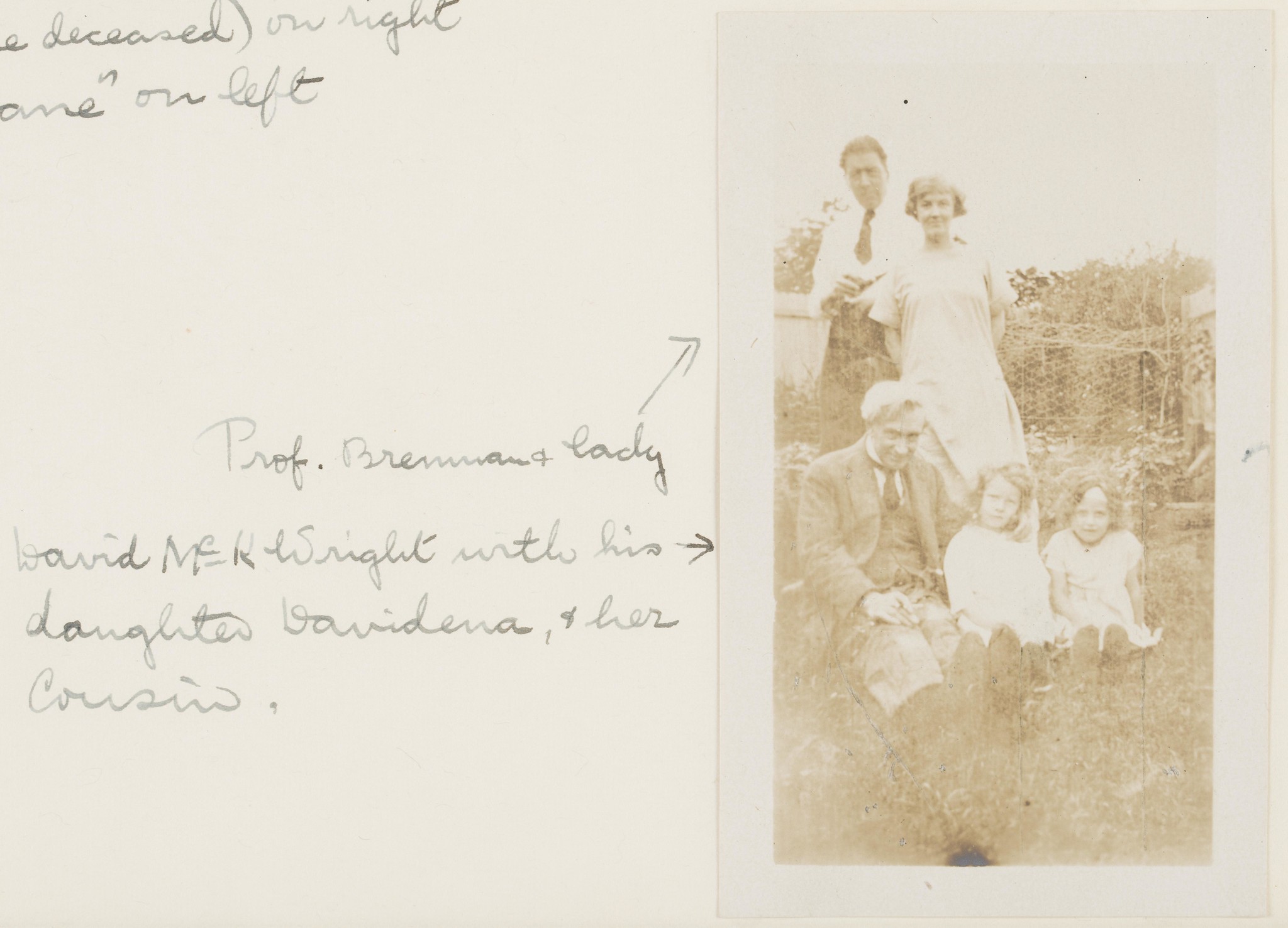
Davis McKNight, Davidena Cross, Christopher Brennan, Angus and Robertson pictorial material - Portraits of authors and sketches. Call number: PXE 1264 V.258 010e, circa 1920- 1925 courtesy State Library of NSW.
The National Library of Australia, in the records it holds of Prof. Brennan's works has:
Michael Angelo'S Sonnet XVII: Englished (Item 50)
Autograph manuscript. 1p. 4to.
This translation varies from that published by Brennan in Art in Australia, February 1923.
The script is headed: "For Winifred Brereton now the third of the good women who have looked after me My prelude to Vie done practically under her eyes Xmas 1922 for her 35th birthday Silvester '22* and the rest remains to be written
The text of the sonnet follows, and at its conclusion is written: "This he wrote to Vittoria Colonna, whom even dead, he did not dare to kiss. Copied at Wollombin June 11 1925 Chris: Brennan."
Brennan has made no attempt to make this into a showpiece. He has written it in his "ordinary" hand-writing, which is very different from that used by him for so many of his manuscripts, and letters. Usually when writing out a poem for a friend, Brennan extended himself to produce an attractive manuscript.
The reference here is to Vie Bird, Brennan's close friend, who was killed in tragic circumstances on the night of 8 March 1925. Brennan was greatly distressed, particularly because at the time the couple had quarrelled and were estranged.
"Wollombin" was the name of the Brereton house at Mosman. In addition to visiting, Brennan had on occasion stayed there with the family. In quarter-leather folder.
Inserted is autograph letter from Mrs Winifred Brereton; a pleasant and affectionate letter to her husband, congratulating him upon his appointment to the Chair of English Literature at the University of Sydney. Brereton was absent from home when the news was announced in the papers. Mrs Brereton received the news from Mrs Bertha Lawson by telephone.
Included also is telegram of congratulation from Brennan. It is sent from Newport, 14 December 1920, and reads simply: "Hooray! Brennan".
His first daughter married in 1928 - the marriage was registered at Manly.
NSW BDM's: 3569/1928 GIBSON JOHN BRENNAN ANNA H MANLY
Anna died the next year, 1929, her husband preceded her by months:
NSW BDM's: GIBSON ANNA 20773/1929 CHRISTOPHER JANNA E NORTH SYDNEY
GIBSON. — February 8th, 1929, at St. Vincents Hospital, Darlinghurst, John, dearly loved husband of Anna, Excelsior Flats, 96 Curlewis Street, Bondi, aged 39 years
GIBSON. — The Relatives and Friends of Professor CHRISTOPHER BRENNAN are kindly invited to attend the Funeral of his dearly beloved son-in-law, John Gibson, to leave Mrs. P. Kirby and Son. Ltd., Private Mortuary Chapels, 265 Elizabeth Street, City, THIS MONDAY, at 2.30 p.m.. for the Presbyterian Cemetery. Waverley. Motor FuneraL Mrs. P. KIRBY AND SON. LTD., Motor Funeral Directors. 265 Elizabeth Street. City. Phone, M2221-2 Family Notices (1929, February 11). The Daily Telegraph (Sydney, NSW : 1883 - 1930), p. 10. Retrieved from http://nla.gov.au/nla.news-article245517313
DEATHS
GIBSON. — 3rd October, 1929, at King St., Naremburn, Anna, dearly beloved daughter of Mr. and Mrs C. J. Brennan, and widow of the late John Gibson; aged 30 years. R.I. P. Family Notices (1929, October 4). The Daily Telegraph (Sydney, NSW : 1883 - 1930), p. 7. Retrieved from http://nla.gov.au/nla.news-article246852304
Despite his wife deciding not to proceed with the divorce they didn't appear to live together as a family, or at Newport, again. He spent much of 1926 as house-guest of Hilary Lofting:
"ONLY MAJOR POET."
Christopher Brennan.
"Christopher Brennan is our one major poet, and there is no published collection of his works. It is a standing disgrace."
This statement was made by Mr. Hilary Lofting, the author, at a meeting of the fellow ship of Australian Writers at the Shallmar Cafe last night, when he pleaded for recognition of the poetical talents of the late Christopher Brennan.
Mr. Lofting said that Brennan had been a member of his household during one of the last years of the poet's life. One had almost to study Brennan's work before one could like it. "ONLY MAJOR POET." (1936, July 16). The Sydney Morning Herald (NSW : 1842 - 1954), p. 10. Retrieved from http://nla.gov.au/nla.news-article17252308
In 1927 he taught at the Marist Brothers' High School, Darlinghurst, following which he suffered real privation. In July next year friends and admirers instituted a fund to assist him in paying for necessities of what had become a very modest (though still disordered) style of living. In 1930 he became a part-time teacher of modern languages at St Vincent's College, Potts Point, a position he held, with some happiness, until his last illness. In March 1931 he was given a Commonwealth Literary Fund pension of £1 a week.
From 1925 onwards, Brennan had reverted more and more to a generally Catholic orientation. He returned fully to the beliefs and the practices of Catholicism in mid-1932; while seriously ill in St Vincent's Hospital. [1.]
Professor Brennan died of stomach cancer on October 5th in Lewisham Hospital and was buried in the Northern Suburbs cemetery. He left his estate, valued for probate at just over £68, to Robert Innes Kay, solicitor.
Tributes to the gentleman were published extensively and throughout Australian newspapers - two examples:
OBITUARY.
MR. C. J. BRENNAN.
Mr. Christopher J. Brennan, formerly asso-ciate professor of German and Comparative Literature at the Sydney University, died yes-terday in his 62nd year.
An Australian by birth, Mr. Brennan was educated at Riverview College, his original Intention being to train for the priesthood. Later he distinguished himself highly at Sydney university in his studies in Classics and Modern Literature, obtaining honours in the former subject at all examinations. He received his B.A. degree at the age of 21 years, and the gold medal for philosophy, and, two 5'ears later, with the aid of a post-graduate scholarship, he went to Europe, studying mainly at the University of Berlin. It was then anticipated that he would there attain the Ph.D. degree, but instead of coming back with a doctorate of philosophy or classics, he re-turned with a thorough knowledge of German and a burning enthusiasm for contemporary French poetry, particularly the symbolists.
After his return to Australia In 1895, he became chief cataloguer at the Public Library. Two years later he obtained his M.A. degree, and in 1908 he joined the Department of Modern Literature at the University as lecturer, acting also as examiner in Latin and modern languages at public examinations and Public Service examinations. In 1920 he received the appointment of McCaughey Associate-Professor In German and Comparative Literature, which he held until 1928. This was a new position created for him because of his wonderful knowledge of the literature and languages of the world. The title still exists but the present holder of the post deals only with German. Mr. Brennan contributed many valuable articles of literary and philological interest to European journals, his articles on the "Manuscripts of Aeschylus" commanding great attention. Indeed. Mr. Brennan's classical scholarship was recognised abroad better, perhaps, than in this country, for he was know here, to others than his University associates, mainly as a poet, among his principal works being "Twenty-one Poems," "The Chant of Doom," and "Towards the Source." The greatest literary Influence on his poetry was that of Mollarme.
While in the service of the University Mr. Brennan learned that some of the evening students were desirous of studying Greek litera-ture, and as no course was provided for them he himself lectured In an honorary capacity in Greek literature. He was familiar with the languages and literatures of ancient Greece and Rome and of modern England, Germany, France, and Italy. On and off, for many years, he was engaged In preparing an edition of the works of Aeschylus, the "father" of Greek tragedy, which, however, has not yet been published. Mr. Brennan Is survived by Mrs. Brennan and two sons, Christopher and Rudolf. The funeral will take place to-morrow. OBITUARY. (1932, October 6). The Sydney Morning Herald (NSW : 1842 - 1954), p. 10. Retrieved from http://nla.gov.au/nla.news-article16922426
A DISTINGUISHED SCHOLAR
Christopher Brennan's Proficiency as a Linguist
Mr. Christopher John Brennan, formerly associate professor of German and Comparative Literature at the Sydney University, died on Wednesday, October 5, in his 62nd year. An Australian by birth, Mr. Brennan was educated at Riverview College for a time. Later he distinguished himself highly at Sydney University in his studies in Classics and Modern Literature, obtaining honours in the former subject at all examinations. He received his B.A. degree at the age of 21 years, and the gold medal for philosophy, and, two years later, with the aid of a post-graduate scholarship, he went to Europe, studying mainly at the University of Berlin. It was then anticipated that he would there attain the Ph.D. degree, but instead of coming back with a doctorate of philosophy or classics, he returned with a thorough knowledge of German and an enthusiasm for contemporary French poetry, particularly the Symbolists. After his return to Australia in 1895 he became chief cataloguer at the Public Library. Two years later he obtained his M.A. degree, and in 1908 he joined the Department of Modern Literature at the University as lecturer, acting also as examiner in Latin and modern languages at public examinations and Public Service examinations. In 1920 he received the appointment of Mc-Caughey Associate-Professor in German and Comparative Literature, which he held until 1928. Mr. Brennan is survived by Mrs. Brennan and two sons, Christopher and Rudolf. The funeral took place on Friday last, after a Requiem Mass at St. Canice's Church, Roslyn-street, Darlinghurst. R.I.P. A DISTINGUISHED SCHOLAR (1932, October 13). Advocate (Melbourne, Vic. : 1868 - 1954), p. 5. Retrieved from http://nla.gov.au/nla.news-article174622061
A little about his funeral service:
LATE MR. C. J. BRENNAN.
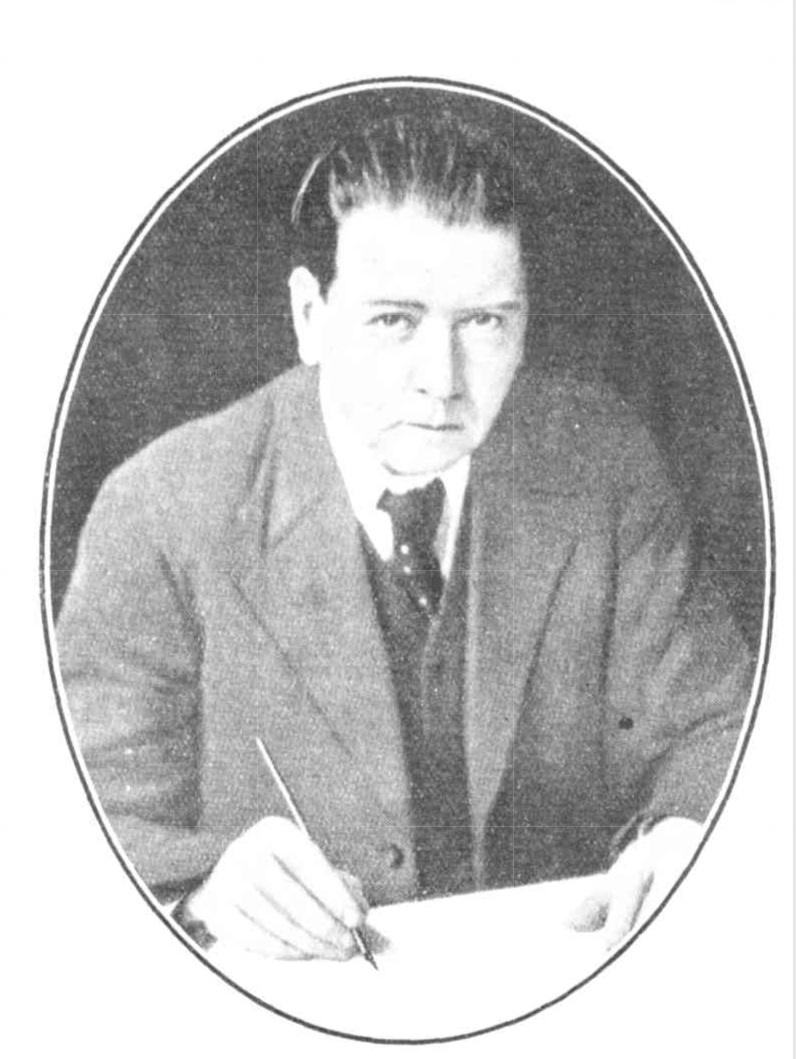
Australian literature lost a good friend in the death in Sydney last week of Mr. Christopher J. Brennan. Originally intended for the priesthood, Mr. Brennan so distinguished himself in classics and modern literature at Sydney University that he won a post-graduate scholarship and spent two years at the University of Berlin, where he devoted much time to the study of contemporary French poetry. Later he joined the Department of Modern Literature at the Sydney University, and subsequently, because of his remarkable knowledge of the literature and languages of the world, a special post was created for him, that of McCaughey Associate-Professor in German and Comparative Literature. He contributed many valuable articles of literary and philological interest to European journals, but was best known locally for his poetry, notably 'The Chant of Doom,' 'Towards the Source,' and 'Twenty-one Poems.' He was in his 62nd year.
The funeral was largely attended, and at the conclusion of the service Professor Le Gay Brereton, a former colleague, delivered a valedictory oration. At the University the Dead March was played on the War Memorial Carillon and the flag was flown at half-mast. LATE MR. C. J. BRENNAN. (1932, October 12). Sydney Mail (NSW : 1912 - 1938), p. 14. Retrieved from http://nla.gov.au/nla.news-article16622495
The National Library of Australia, in the records it holds of Prof. Brennan's works has records that show Anna his wife was at Newport during his passing:
Southerly. Chris Brennan Number No.4, of 1949 (Item 78)
In quarter-leather binding.
This number is valuable for the many good things about Brennan, by various writers. In his "Personalia", Professor R.G. Howarth writes of his meetings with Mrs Brennan, and members of the family.
(a) Autograph note by Brereton: an extract from his pocket diary, dated 10 May 1904: "Brennan is always at feud with his mother-in-law, whose defences are lamentations, and an alliance with Mrs Brennan. One excuse for dispute is the opening of certain doors at the back of the house, which he thinks should be kept shut, when he is at home, to prevent a more than half imaginary draught in his study. He told me how he demonstrated the existence of this drought by hanging on fine threads several pieces of light paper in such a way that they just reached a crack under the door. They moved. He brought his wife in triumph to see them. To his rage, she laughed and brought her mother".
(b) Two letters from R. Innes Kay to Lionel Lindsay, 4th, and 5th October 1932. He writes on behalf of the Committee informing the subscribers to the Brennan Sustenance Fund, that the poet is in the Lewisham Hospital and has not long to live, and suggesting that they may wish to visit him whilst there is yet time. In the second of the letters he announces Brennan's passing, and that he is accepting the responsibility of arranging for the burial.
(c) A.G. Stephens's own copy of his letter to Mrs Brennan informing her of her position in respect to the Pension of £1 per week, drawn by her husband since the beginning of 1931. He writes: "The Parliamentary vote "is for...families of literary men who have died poor...You have good legal right for the continuance of the pension to you." The letter is dated by A.G.S. 12 October 1932. The rate of £1 weekly was at that time the highest rate provided for.
(d) Autograph letter from Mrs A.E. Brennan to A.G. Stephens, written from Newport, 15 October 1932. "I wish to thank you for your great kindness towards me, by informing me in regards as to how I stand in relation to my late husband's literary pension. When Mr Brennan died, he left nothing, and in consequence I have no source of income. I will make application for this pension to the proper authorities without delay. Thanking you ever so much."
(e) Small photograph of Mrs Brennan.
(f) Copy of Southerly, No. 3, of 1957. "Brennan Anniversary Number".
A Brennan Album. A large album in half-morocco (Item 96)
(a) Original etching by Sir Lionel Lindsay, "Of old, on her terrace at evening", inscribed, "To my friend Harry Chaplin, Lionel Lindsay".
(b) Reproduction in colour of Brennan's old home at Newport.
(c) Original etching by Sir Lionel Lindsay, of Brennan in profile, together with the annotation by the artist to H.F.C.: "...I looked up the Dixson list and find he hasn't got it..."
Pencil working sketch of the above for conversion to a bookplate for H.F.C., together with the first proof, showing the "s" in Ex Libris reversed, also second state with the error corrected.
(d) Etched and woodcut portraits of Brennan by Sir Lionel Lindsay.
(e) Autograph letter from Miss Esme Hadley to J. Le Gay Brereton, 4pp, 19 October 1932, entirely devoted to her friendship with Brennan, with commentary upon his death.
(f) Autograph letters to Rolf Brennan from a friend.
(g) Photo-copy of Brennan's Will, together with statement of assets and liabilities. The net amount for probate being £68.5. 6.
(h) Photo-copy of the Will of Anna Helena Gibson [Brennan] dated 13th March 1929.
(i) Typescript copies of letters from Brennan to F.S. Delmer, at Koenigsberg University, 4pp, fcp. December 1900. Much about Mallarme. "...I grant you a grain of affectation here and there, natural in a man moulding his language to a new gesture, but that affectation is the basis of his style is to me inconceivable. 'Inartistic obscurity' - well, I can only say that I understand him from one end to another and that no commentator has ever helped me; I have simply applied the corporeal understanding - as to any other writer." Another comment: "I have been reading Blake's prophecies and am now proceeding, along the track of the Gnostics, towards the East, to find a mysticism without personal God "or personal immortality, wherein to forget the vain hubbub of the West with its parochial religions, and no less parochial atheisms - Nietzsche is a parish brawler after all..." He refers to The Burden of Tyre and that it is not ready, the work of revision "demands more time and eye-sight than I have just now, but you'll get a copy as soon as it is finished". References to the home being built at Mosman, and other domestic matters. [Long and interesting letters. The copies very kindly given to me by Miss M.S. Delmer.]
(j) Original pen and ink portrait of Brennan by Sir Lionel Lindsay.
(k) Other items of interest, including photograph taken by R.G. Howarth of a friend wearing Brennan's top hat.
_____________
Guy Jennings records that Elizabeth continued to live at Newport and was often seen fishing at Pittwater or the rocks at Little Reef. She passed away on June 18th, 1943.
BRENNAN. -June 18. 1943 (suddenly) at her residence, Myola Avenue, Newport Beach, Ann Elizabeth, beloved mother of Rudolph, aged 74 years. At rest.
BRENNAN - The Relatives and Friends of Mr. Rudolph Brennan, of Myola Avenue, Newport Beach; also of Mrs C J. Brennan (Bronte) are Invited to attend the Funeral of his beloved Mother and her dear Mother-in-law, Anna Elizabeth ; to leave T. Waugh and Co '.s Funeral Chapel. 92 The Corso Manly. This Monday, at 11 a m. tor the Church of England Cemetery Manly. Thomas Waugh & Co Pty. Ltd. Ph MA6013-4 Established 1836. Family Notices (1943, June 21). The Sydney Morning Herald (NSW : 1842 - 1954), p. 8. Retrieved from http://nla.gov.au/nla.news-article17853488
Christopher John Brennan influenced Australian writers of his own generation and many who succeeded him, including R. D. Fitzgerald, A.D. Hope, Judith Wright and James McAuley. In remembrance, the Fellowship of Australian Writers established the Christopher Brennan Award which is presented annually to "an Australian poet who has written work of sustained quality and distinction".
Brennan Hall and Library at St John's College within the University of Sydney, the Christopher Brennan building in the University's Arts Faculty, and the main library at Saint Ignatius' College, Riverview are named in his honour.
There was for several decades a Christopher Brennan Society "founded in... the 1970s by Axel Clark, Robin Marsden and John Fletcher", whose patrons included "some who knew Brennan: Professor A. R. Chisolm; Margaret Delmer; Professor Farrell; Sister Peter, of the Sisters of Charity; Walter Stone; Professor G. P. Shipp; Richard Pennington".
He was eclectic, he was spiritual and worth reading - if only to revisit as a human being how poetics and symbolism within poems can connect you to the greater 'converse' that is always going on. This was what he was attempting to do.
"'Brennan is one of the first legendary figures in Australian literature. Unresponsive to, and seemingly uninfluenced by, the forces of nationalism and radicalism that dominated the contemporary Australian scene, he was a literary enigma standing apart from his own social and literary milieu, finding instead a literary affinity with the French symbolist writers...he is clearly part of the international mainstream of writing that gave rise to poets such as T.S. Eliot and William Butler Yeats.' - The Oxford Companion to Australian Literature
The home at Newport 'Oceania' passed into other hands after Elizabeth died:
SURF MEN FIGHT BUSHFIRE
Fifty members of the Newport Surf Club helped to save six houses when they fought a bushfire yesterday.
The fire was one of 14 bush-fires in Sydney suburbs. The Newport surfers were having a beach gear inspection when they noticed a fire about 2 p.m. They quickly changed from beach costumes and picked up firebeaters or tore branches from gum trees as they ran to the fire. They were in time to relieve a handful of residents who were putting up a hopeless fight against the fire. Six houses, in Myola Road and Little Reef Road, were in danger. Flames were already scorching the walls of an old weatherboard and stone six-roomed house, which once belonged to Chris Brennan, the poet. The house is now occupied by Mr. Tom Jones and his wife. The fire also scorched the walls of a fibro house and a new weatherboard house.
Hoses In Truck Avalon Volunteer Fire Brigade, to which six members of the surf club belong, drove by truck with hoses from Avalon where they had been fighting another bushfire. They directed the hoses on Mr. Jones' house just in time to save it. A woman burning rubbish caused the fire. Sparks from her rubbush fire flew over the fence and set fire to four acres of dead paspalum and scrub. Mr. Tom Jones said last night: "If the fire had got completely out of control more than fifty houses on the headland at Newport would have been in danger " SURF MEN FIGHT BUSHFIRE (1948, October 18). The Daily Telegraph (Sydney, NSW : 1931 - 1954), p. 7. Retrieved from http://nla.gov.au/nla.news-article248380905
Christopher Bennan lost his post at Sydney University through drink and an adventure
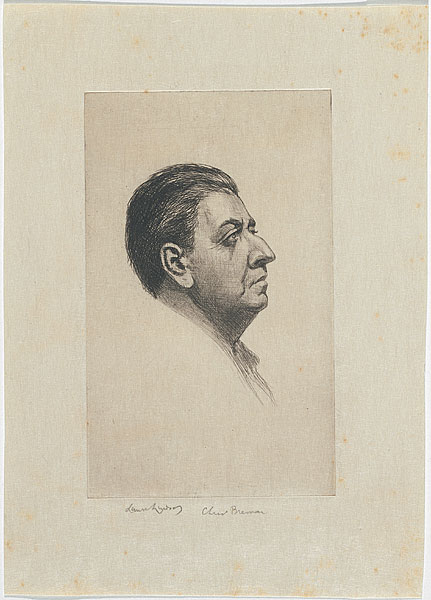 CHRISTOPHER BRENNAN, as seen by Lionel Lindsay.
CHRISTOPHER BRENNAN, as seen by Lionel Lindsay.
"HEAVEN doth with us as we with torches do, not light them for themselves," wrote Shakespeare.
It is a saying exemplified in the lives of all of us, who, even in our most selfish actions, serve purposes not our own; but it is pre-eminently true to those men to whom we apply the title of "genius" whose lives are consumed to produce the blaze of their great works and acts. On October 5, 1932, there died in Lewisham Hospital, Sydney, a huge man whose great, leonine mane of black hair falling over the pillows framed a handsome face dominated by an eagle nose.
An impressive-looking man, you would have said. Alive he had "fascinated several generations of students" at Sydney University and "dominated all the artistic and bohemian circles that mattered in the Sydney of the early twentieth century." He had been for five years associate professor in German and comparative literature at the University of Sydney. He was famous as a speaker at the well-known Friday luncheons held by a group of French-speaking artists and writers (The "Compliques") at Paris House in Phillip street during the 1920s. Secretly he had written poetry published at his own expense in small editions that made little impression on the general public. It was solely as a scholar and "man about town" that he impressed his contemporaries.
It was not until a fortnight after his death that any Sydney newspaper saw fit to print his obituary, and even then it was a casual affair, four inches long at the bottom of a column of an obscure page - most of it devoted to damning the work of another writer - the banned "Ulysses" by James Joyce. No mention of Brennan's achievements, except the bald statement that he was a scholar of renown, and a formidable conversationalist. No mention of his poems, not even the title of his books. Nothing, but a fair example of Brennan's very rare narrow mindedness! ***
Brennan himself, supreme ironist that he was, would have enjoyed this joke. He would have chuckled equally at the critical see-saw which has been set up subsequently -- for today Brennan is the most debated Australian poet. The ordinary reader of today has been unable to make up his own mind on the matter, since Brennan's poetry has long been out of print, apart from odd poems in anthologies and an expensive and incomplete edition of his work ("23 Poems") published in the "Australian Limited Editions" series in 1938. Judged by the highest academic standards (not by paper qualifications), Brennan was one of the most profound scholars of European literature, ancient and modern that Sydney University has ever known.
Notwithstanding this he was dismissed by a majority vote of the University Senate in 1925, following "an amorous adventure" and involvement in a court case. It also alleged that he had taken to drink and was irregular in at-tending to his professorial duties. The last years of Brennan's life were tragic. He was buffeted from pillar to post and although he did everything in an endeavour to rehabilitate himself he finally sought complete solace in drink.
Harassed by debts and remorse he lived in various rooming houses in and about Sydney, finding his meals as often as not from the generosity of cafe proprietors whom he had patronised in his affluent days. His parents were good Catholic folk and as a boy Brennan passed through various Catholic schools, and was for some time an acolyte in the old church of St. Francis, where the colors of the stained glass windows and of the vestments were, as he later admitted, his first and never-to-be-forgotten experience of human art.
As well as the parish school of St. Francis, he attended in his early years St. Kilda College, Hyde Park, where he began his study of Latin and French. The late Cardinal Moran having established a scholarship to Riverview College, the Jesuit establishment on the Lane Cove River. Brennan was awarded it and went to this school about 1884, in his fourteenth year. He first began the serious study of poetry in 1886 (his sixteenth year), when he sat for the Senior Public Examination and his classical master, Father Pat Keating, set him writing Greek and Latin verses. Brennan was a boarder and took a great interest in sport, especially rowing and handball. He was also an adept swimmer. In his last year at Riverview he began learning Italian and German.
In 1888 he matriculated to the University of Sydney and entered the faculty of arts, studying philosophy and the classics, a combination that presented a formidable barrier of subjects in those days, including mathematics as well as many literary, historical, and philosophical subjects. At first he excelled in classics (Greek, Latin), but later surpassed himself in philosophy, by which time his religious faith had come to be neglected. During the final stages of his university course he took a teaching post at St. Patrick's College, Goulburn, but despite this distraction he managed to graduate MA with honors in classics in 1892.
Already his abilities had singled him out for special notice at the university. In the last year of his course he associated with two members of the staff, Thomas Butler and A. B. Piddington, professor of Latin and senior lecturer in English, respectively These two commenced Brennan's education as a gourmet, by dining and wining him at the Athenaeum Club and other places. It was at the Athenaeum Club that Brennan met and made friends with Sir Edmund Barton, one of the fathers of the Australian Constitution and the first Prime Minister of the Commonwealth. Thus at the early age of 22. Brennan's remarkable intellectual attainments and personal charm had already won for him the regard of some of Australia's most outstanding men. With such a start his future seemed assured. He had already written some verses, but these had not been published in any journals of note, and had nothing to do with his growing reputation at that time. Further distinction was not long delayed.
He was awarded the James King Travelling Scholarship for classics, and in June, 1892, he sailed for Germany aboard the small NDL steamer Hamburg. His choice of Germany as a place to study classics was not as remarkable as it appears, since the University of Berlin enjoyed in those days a reputation second to none in the world for classics. Brennan had not studied the German language sufficiently to speak it when he set sail, but he studied hard at it on the boat and his subsequent two years in Germany made him a fine scholar of that country's language.
He spent his whole two years in Berlin lodging with a Frau Werth, whose daughter, Elizabeth, he subsequently married. His future mother-in-law is alleged to have disapproved of the marriage from the start, but Brennan's early love poetry, written after his return to Australia and before his bride-to-be followed him, witnesses to the intense love with which the marriage opened. Frau Werth's lack of enthusiasm for the courtship of her daughter by Brennan was doubtless due to his unmethodical, untidy habits in her house, his keeping of odd hours, and his already great capacity for drink. Meantime Brennan read widely in the classic authors and commenta-tors, and even more widely in German romantic literature.
In September, 1893, he bought a copy of the French poet Mallarme's "Verse and Prose"-- a book which caused him not only to destroy all of his own poetry he had in hand, and determined him to write in a symbolist style, but doubtless gave Frau Werth fresh cause for dismay. Had she known, which is doubtful, exactly what was going on in Brennan's mind, she could have not been more concerned than she was to learn that he was neglecting his formal studies, and he had decided not to bother about taking his degree at the end of his course. In her opinion Mallarme could not have been a far less sound mentor for the prospective breadwinner of her daughter than Prof. Butler, Mr. Piddington. MA. or Sir Edmund Barton. These three gentlemen had not only gained each a respectable competence, but had made worthy reputations for themselves; but Mallarme was only a starving poet with very singular, not to say improper, ideas about life.
He asserted, for instance, that the most important thing in life was not earning money or worldly repute, but "making the mind visible" - a proceeding he undertook by writing poems consisting to the uninitiated, of cryptic phrases arranged haphazardly to form a verbal puzzle.Ordinary Ordinary poetry. Mallarme called "reporting" and attached little literary value to it. Without a German degree and leaving his fiancee behind until he should have settled into a suitable position in Australia and had a home to offer her, Brennan re-returned to Sydney in 1894 . Sydney University authorities were doubtless disappointed at the use to which he had put his scholarship and no offer of a teaching post on the university staff was forthcoming, so Brennan joined the staff of Sydney's Public Library, where he catalogued books. In 1897 he published privately his "XVIII. Poems," and an edition of 200 of "XXI. Poems," being his earliest surviving poetry. It was not markedly like Mallarme's poetry but sufficiently unusual to call for a comment in a new out-of-the-way literary quarters of the day.
Later in 1897, Anna Werth arrived out from Germany, and Brennan married her in December of that year. Four years later Frau Werth and another daughter arrived, and Brennan set up house for them all in Mosman, where his four children were duly born.
In 1908 Brennan's natural brilliance of mind earned him a junior post on the University staff, and he acquired four acres of land on which was a stone house (still in existence at Newport), where he spent much of his time.
In 1913 Brennan collaborated with Le Gay Brereton in a now forgotten "Mask"; in 1914 he published "Poems 1913," and in 1918 "The Chant of Doom." In 1920 he was appointed associate professor in comparative literature at Sydney University. His best known poems and one of his most comprehensible is "The Wanderer," which presents Brennan's view of life. He died a confessed Catholic and recanted many of his former opinions, but it is not improbable, that even at that solemn juncture, he would still have maintained as he always had: "Fundamentally nothing matters except beauty. It is the ultimate; even scholarship is secondary to it, just as philosophy at last is the only handmaid to poetry." Christopher Brennan lost his post at Sydney University through drink and an adventure THE PROFESSOR WAS A POET (1954, December 3). News (Adelaide, SA : 1923 - 1954), p. 26. Retrieved from http://nla.gov.au/nla.news-article131218020
C. J. BRENNAN.
A few days before the death of Mr. A. G. Stephens was published his study of C. J. Brennan, who predeceased him by only a few months, and to the public appreciation of whose remarkable gifts Mr. Stephens had con-tributed much by offering them facilities for expression. Brennan was not a "popular" writer. His work in poetry and prose was read by comparatively few. It was small in volume, and both its content and the form in which it was published denied it a general appeal. Yet any discerning estimate of Aus-tralian letters awards Brennan a very high place.
Still Mr. Stephens is not blind to certain limitations in Brennan, who, as other men of great learning have been, was "encumbered with intellectual paraphernalia" in his Parnassian expeditions. He was often stiff, wanting heat to set his words in motion, and, although he was capable of finely sonorous passages, he was deficient in a sense of sheer melody. He was probably the best all-round scholar that the University of Sydney has ever produced. Before his appointment to the chair of German, he had deputised for absent professors in Greek, Latin, French, and German, and had assisted in English. Very few men would have been competent to assume such varied responsibilities. As Mr. Stephens says, the width of his knowledge was extraordinary. A small slip occurs in a reference to a former lecturer in modern languages at Sydney University. He is described as Dr. "Marks." This is presumably Dr. Max, an Austrian of broad culture and, as was commonly understood, an aristocrat ex-patriated for political reasons. (Published by "The Bookfellow.") C. J. BRENNAN. (1933, April 22). The Sydney Morning Herald (NSW : 1842 - 1954), p. 8. Retrieved from http://nla.gov.au/nla.news-article16987167
Biographers may have mixed up his son with himself in terms of stating he was divorced by his wife - almost a decade after Prof. Brennan passed away. Chris Brennan, the son, was also a Newport SLSC member. He was a member of the successful Newport Surf Boat Crew of the 1924-25 season that secured 3rd in the Australian Titles in February 1926.
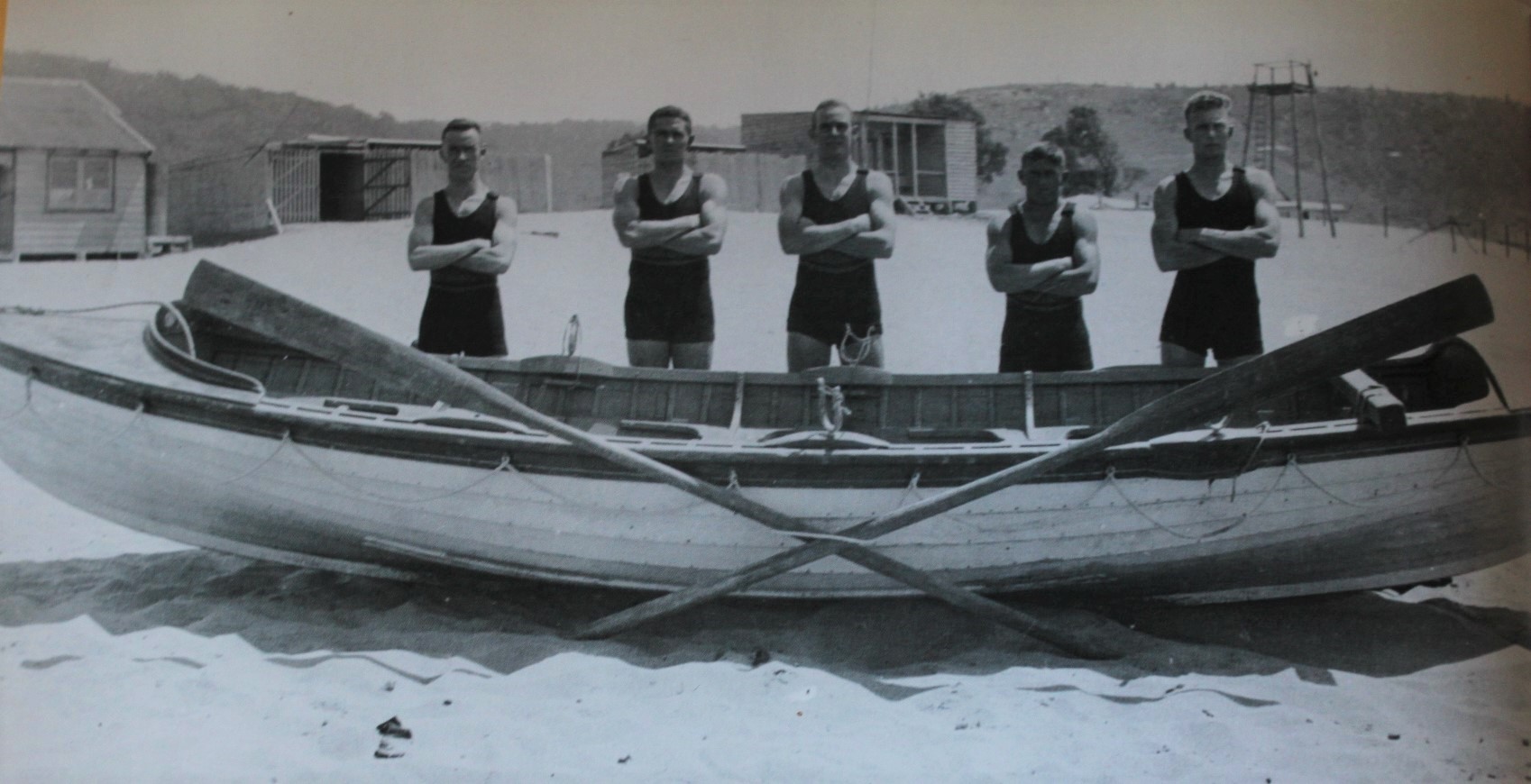
From left: George Meillon, G.D. Banks, A. M. Stayner, Chris Brennan and Gordon Robertson. The Clubhouse can be seen in the background on the left - the boatshed and change sheds and shark tower are also visible.
Chris was appointed beach inspector for Newport Beach on December 20th, 1926 (some records state his appointment started from December 13th). As such he was he was the very first employed lifesaver on the beach. His wages were £5 per week, half paid by Warringah Shire Council and the rest met by the surf club itself. The club stated, on nominating him that;
'he is a very conscientious worker and we could not get a better man', also that 'Mr. Brennan has lived at Newport for many years and his knowledge of the beach is extensive. He is a powerful swimmer and being a member of this club, he has a thorough knowledge of Life Saving methods as taught by the Surf Life Saving Association of Australia, including resuscitation, care of patient etc.'
More Surf Boat adventures:
FOUNDERED IN HEAVY SWELL
LAUNCH'S CREW HAD TO SWIM
NEWPORT Surf Life Saving Club's new £100 surf boat, which is to be officially launched to-day, was submitted to an unexpected test of seaworthiness yesterday, when the launch which had It in tow foundered. Harry Erickson, Fred Andrews, and Chris Brennan, who were on the launch, jumped off before it sank, and clambered on to the surf boat, in which they reached the Newport beach safely, PROPELLER JAMMED The launch was towing the surf boat from Newport bay to Newport beach, about six miles. Nearing the beach seaweed jammed the propeller, and part of the planking gave way, and the launch quickly filled with water. There was a heavy swell running, and the crew had just time to cast off the tow rope, when the launch disappeared. FOUNDERED IN HEAVY SWELL (1932, October 2). The Sun (Sydney, NSW : 1910 - 1954), p. 2. Retrieved from http://nla.gov.au/nla.news-article229256379
(Before Mr Justice Bavin.)
ROBINSON v ROBINSON.
John Herbert Robinson v Audrey Joanna Robinson (formerly Howarth) and Christopher John Brennan co-respondent. Marriage, October 19, 1935, St. Peters, by Registrar. Decree nisi. Corespondent to pay costs. Mr. S. V. Toose (instructed by Mr. Mervyn Finlay) for petitioner.
BRENNAN v BRENNAN.
Philomena Catherine Brennan (formerly Jarmain) v Christopher John Brennan. Marriage, September 29, 1928, Mosman, Roman Catholic rites. Issue, adultery. Decree nisi. Mr. S.V. Toose (instructed by Mr. Mervyn Finlay) for petitioner. IN DIVORCE. (1940, September 4). The Sydney Morning Herald (NSW : 1842 - 1954), p. 6. Retrieved from http://nla.gov.au/nla.news-article17709427
Goldfields Friendship Led To Divorce Court
On the same allegation of adultery, two petitioners were granted decrees nisi in the Divorce Court yesterday. They are John Herbert Robinson, 30, analytical chemist; of Oliver Road, Roseville, and Philamena Catherine Brennan, 31, of Wau, New Guinea. The suits, which were heard together, were not defended. Robinson said he married Audrey Joanna Robinson, 27 (formerly Howarth), an artist, in 1935, at St. Peters Registry Office. He added: "There were no children, and In February last year we went to New Guinea. "We settled at Edle Creek, near Wau, and the Brennans, who lived nearby, became our friends. "In November last year my wife came to Sydney for', a holiday. Brennan travelled on the same boat.
''Suspected Nothing"
"My wife was to be back home by the New Year, but she wrote saying that she and Brennan had gone on to New Caledonia. "In February this year my wife and Brennan arrived home. "I suspected nothing. My wife lived with me for a month, and then told me she and Brennan had lived together in Sydney. "I saw Brennan and he denied it, but later admitted it was true. . . "I told him I would not stand for it, and came to Sydney immediately. I have a job in Sydney now. My wife has come to Sydney and Is living with her mother.
'Bettered Himself"
Mrs. Brennan (formerly Jarmain) , said she married Christopher John Brennan, 33, in September, 1928, in Sydney. She added: "We lived at Newport and had two children, who are now aged 10 and eight. "During the depression my husband and I went to New Guinea. "He wanted to better himself. He did. He is a building contractor now on the goldfields. "He came to Sydney under doctor's orders. I knew Mrs. Robinson was on the same boat. "A month after his return he told me he had lived With Mrs. Robinson. He said he was fond of her. "Looks Like Divorce" "I said: 'It looks like a divorce,' and he replied. 'Yes, that's right." "He left the house, and I came to Sydney to start proceedings. "I am staying with friends at Kogarah, but will soon return to New-Guinea. I have gold interests there." ' A decree nisi was granted in each case on the ground of adultery at Dalkeith Flats. '
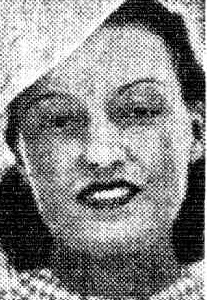
.jpg?timestamp=1553040507137)
Mrs. Audrey Robinson C. J. Brennan.
Goldfields Friendship Led To Divorce Court (1940, September 4). The Daily Telegraph (Sydney, NSW : 1931 - 1954), p. 7. Retrieved from http://nla.gov.au/nla.news-article247616567
Apparently Chris returned to New Guinea just in time to have to escape from the Japanese invasion of that place during WWII. His health never recovered from the stress and he died in Sydney on May 16th, 1942.
BRENNAN.—May 16, 1942, suddenly, Christopher John Brennan, of 445 Bronte Road, Bronte, beloved husband of Audrey Joan. Privately cremated, May 18, 1942 Family Notices (1942, May 19). The Sydney Morning Herald (NSW : 1842 - 1954), p. 10. Retrieved from http://nla.gov.au/nla.news-article17804632
Rudolph, or 'Rolfe' and 'Nipper' as he was known locally, lived on at Newport in a house he built from shells. He would take a snapper he'd caught to the Newport Arms Hotel and raffle it. One local recalls in an anecdote published in Mr. Jenning's The Newport Story, that he always wore a hat but never any shoes.
In Newport Surf Life Saving Club: The First Century 1909-2009, on page 69, Anne Marvell relates; One of the local identities was 'Nipper' Brennan whose father was a professor of English at Sydney University. Nipper wore a red beret and gray slacks rolled up over the ankles and no shoes. He was an expert fisherman and lobster-catcher and used to take my brother John with him around the rocks to catch the lobsters.'
Rudolph continued doing odd jobs and fishing until he passed away on or about June 1st, 1970.
NEWPORT BEACH.
Two Ideal Home Sites, within easy walk of beach, on south end. Elevated position amongst good homes, 66ft frontage X 163It. Oceania Crescent, corner Walworth and Myola Rd, Newport. £500 and £650. Owner at this address week-end; or 'phone JX2818. Advertising (1950, April 10). The Sydney Morning Herald (NSW : 1842 - 1954), p. 12. Retrieved from http://nla.gov.au/nla.news-article18156048

Newport Surf Estate January 3rd, 1920 Item No.: c050400036 Subdivision Materials, courtesy State Library of NSW - and enlarged section showing those who already had holiday homes as marked on the above: names are from top to bottom - Dr. Menzies, W. Crane Esq., L. Henderson Esq., Prof. Brennan, A. G. Yewen Esq., Dr. Morton, D. Lang Esq., F. Kleamo, E. George Esq., C. Websdale Esq., Phizackerley Esq.
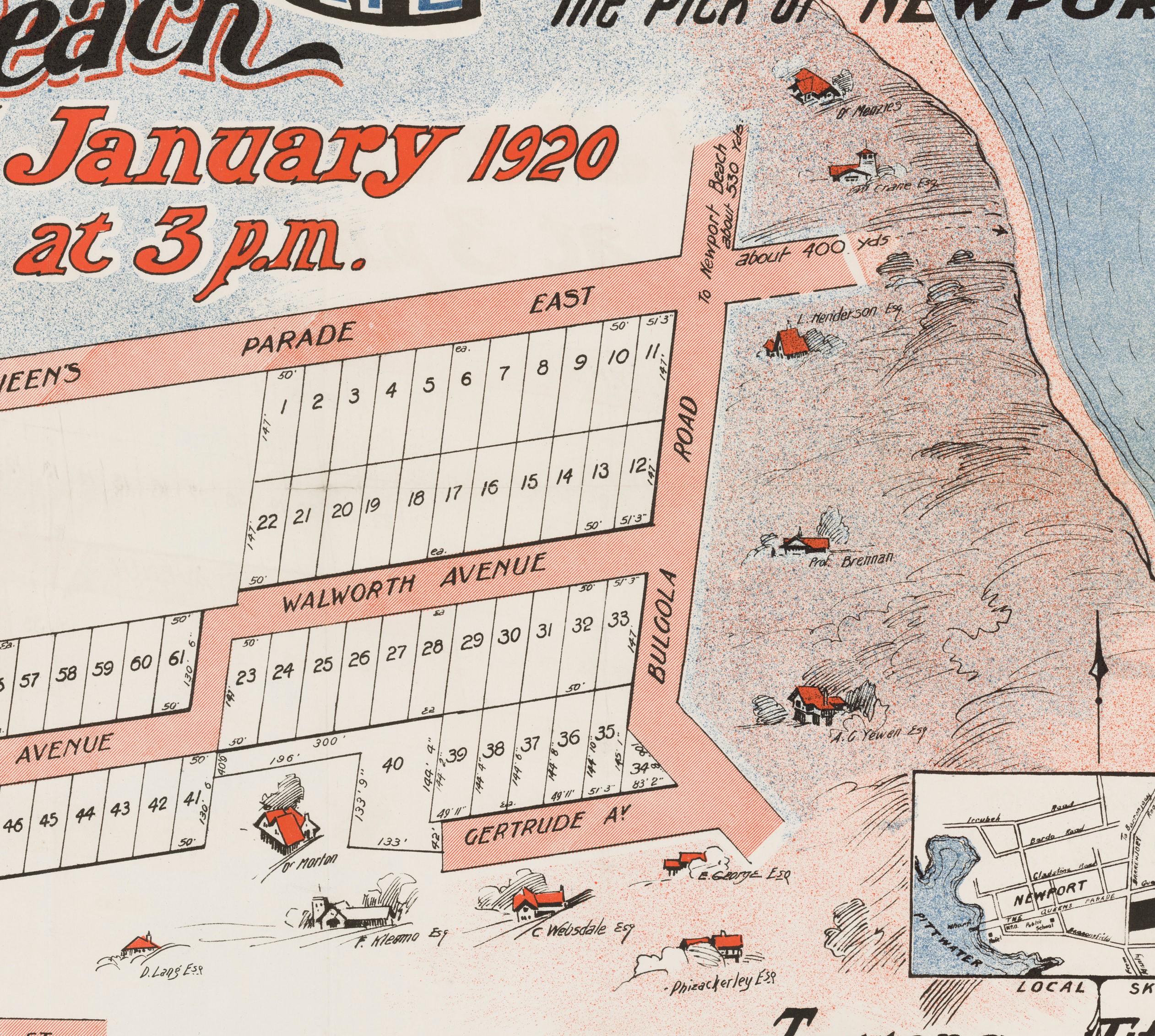
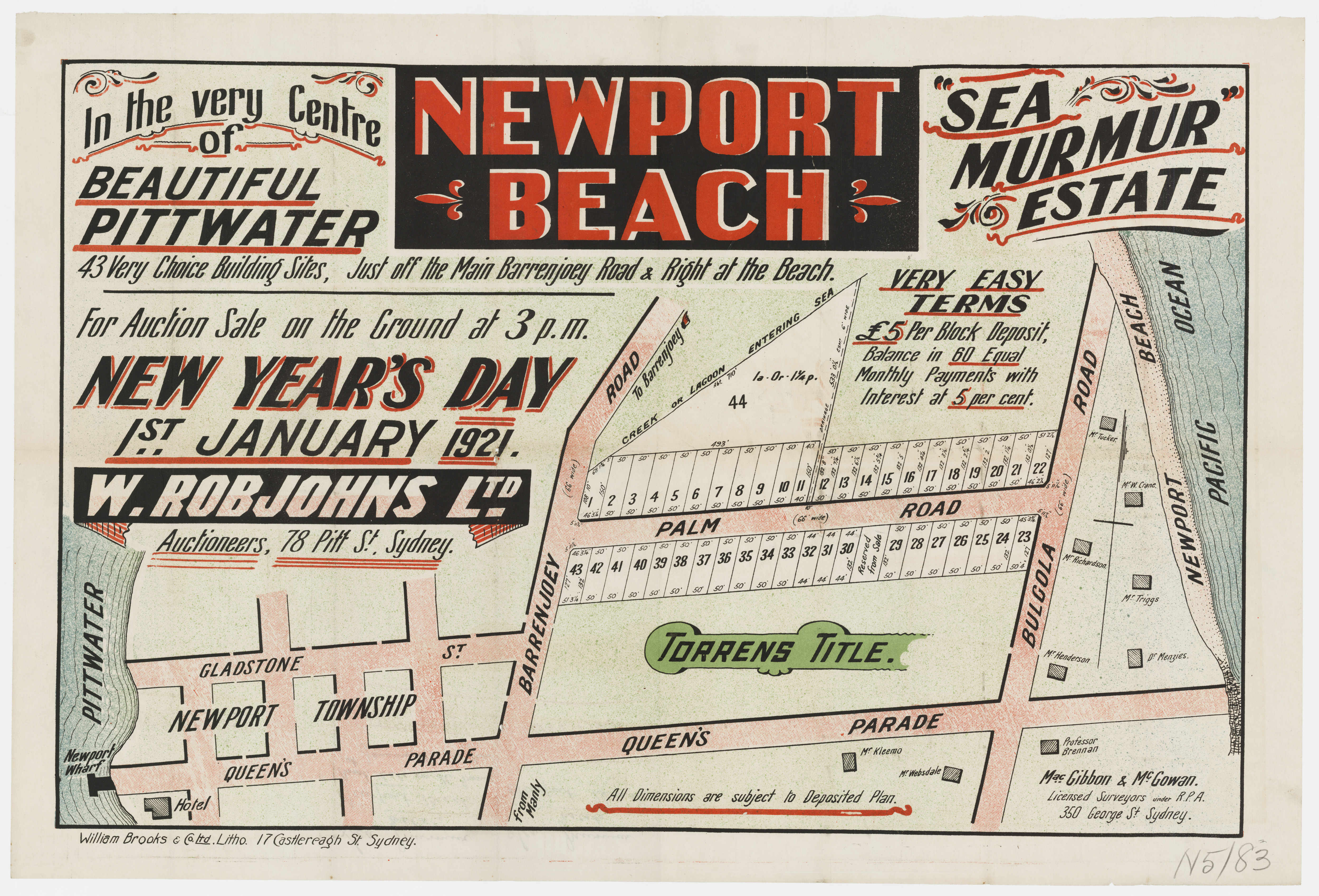
Sea Murmur Estate Jan 1st 1921 Item: c050400058 Subdivision Materials, courtesy State Library of NSW - and enlarged section showing those who already had holiday homes as marked on the above: from top to base are - Mr. Tucker, Mr. Richardson, Mr. Triggs, Mr. Henderson, Dr. Menzies, Mr. Kleemo, Mr. Websdale and Professor Brennan.
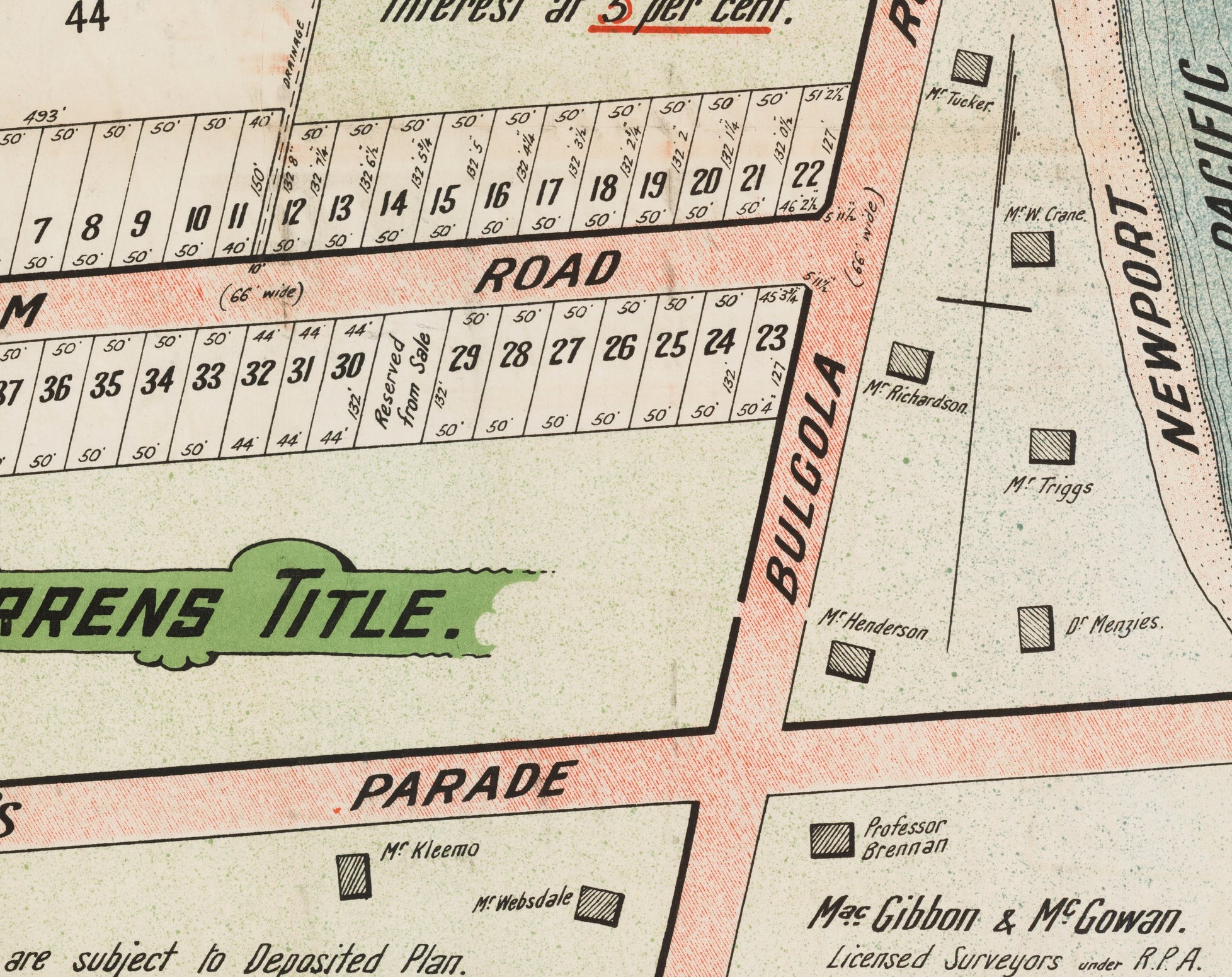
1. Axel Clark, 'Brennan, Christopher John (1870–1932)', Australian Dictionary of Biography, National Centre of Biography, Australian National University, http://adb.anu.edu.au/biography/brennan-christopher-john-5345/text9037, published first in hardcopy 1979
2. TROVE - National Library of Australia
3. The Newport story, 1788-1988 by Guy Jennings. Published. Newport Beach, N.S.W. : ARAMO Pty. Ltd., 1987.
4. Wilkes, G. A. “Brennan and His Literary Affinities.” The Australian Quarterly, vol. 31, no. 2, 1959, pp. 72–84. JSTOR, www.jstor.org/stable/20633526
*** C. J. Brennan was extensively lauded immediately after his passing and for decades later. Over 100 books have been written about him or collating his works. In 1970's, the author of the biography about him, Axel Clark, which appears in the ADB, was among those who formed the Christopher Brennan Society Robin Marsden, Elizabeth Webby and John Fletcher. The numerous thesis on his works, the study of his letters and poems continues to this day.
One of the more detailed versions may still be able to be found for those who wish to know more about the man - although as with any poet, delving into their work with a guide always helps. Maurice Dunlevy, reviewer, speaks of a book published on the thesis Axel Clark wrote - a few extracts:
Kenneth Slessor described the poet Christopher Brennan as the duckbilled platypus of his place and time and Axel Clark's critical biography, 'Christopher Brennan' (Melbourne University Press, 341pp, $25) on the whole supports this view.
A brilliant product of Riverview and Sydney University, he won a scholarship to Berlin to do a Ph.D., but abandoned that enterprise to produce a pioneering paper on the manuscripts of Aeschylus and to absorb the German language and Symbolist poetry.
While the literary men of Sydney wrote about the bush with thumb-nails dipped in tar, Brennan soaked himself in Baudelaire, Rimbaud, Mallarme, Flaubert, Leconte de Lisle, Maeterlinck, Adam and Jarry.
He hadn't enrolled in French at Sydney University but he read wide-ly in it while he was there. He also wallowed in Scott, Tennyson, Swinburne and Meredith and later got to know Wilde, Morris, Lionel John-son, Francis Thompson and Coventry Patmore. Although this reading gave him an unsurpassed knowledge of modern poetry, it also gave him a poetic diction which became a handicap when he wrote his own philosophical verse.
Brennan was also a classical scholar of great erudition, and master of English, French, Greek, Latin, Ger-man and Italian. Although he had more formal education than any of his contemporaries in the literary world, he was by nature an auto-didact who devoured rather than read books. When Dowell O'Reilley told him he should read Milton more, Brennan said he had no need to read him; he knew him. And to prove it, he recited the first four books, of 'Paradise Lost'.
How could mere provincials understand this agnostic who got his MA in philosophy with a thesis entitled 'The Metaphysic of Nescience'? How could they understand this deeply introspective thinker searching vainly for a "final and most general truth"? How could they square this side of him with the wild drinker, the gregarious Bohemian of Sydney's cafe society, and with the Irish-Catholic background which included the role of altar boy in the Parish of St Francis de Sales?
Christopher Brennan, son of a brewer at Tooth's, the clown of Syd-ney University who wore a gown decorated with horseshoes and jam tins, bon vivant and, on occasions, outrageous drunk, gave plenty of evidence of his intellectual and con-versational brilliance, but scarcely any of what Axel Clark calls his self-absorption and inclination to hermetic introspection.
When he poured the products of this introspection into his poetry the critics failed to understand it, just as they failed to understand his philosophical concerns and his literary references. When he brought these facets of his personality into his marriage to the beautiful Ger-man girl, Elisabeth Werth, she also failed to understand them. And so Brennan, in love with the idea of transcendent love, watched his very real marriage to a very ordinary member of the bourgeoisie crumble about him.
WRITERS WORLD (1980, August 23). The Canberra Times (ACT : 1926 - 1995), p. 12. Retrieved from http://nla.gov.au/nla.news-article125617628
